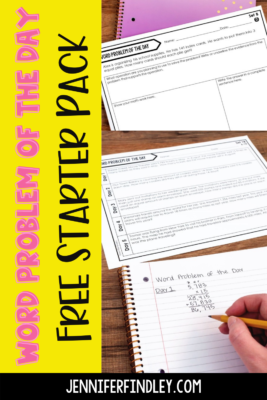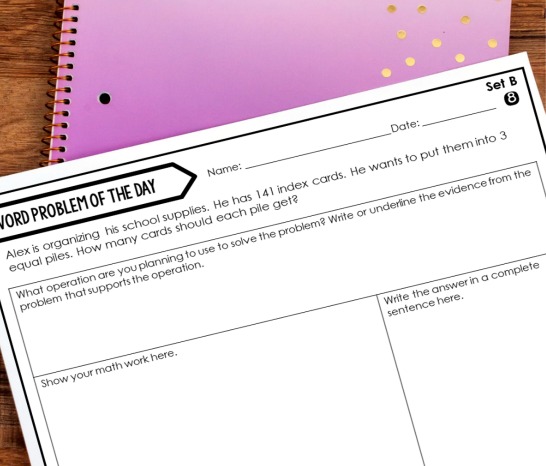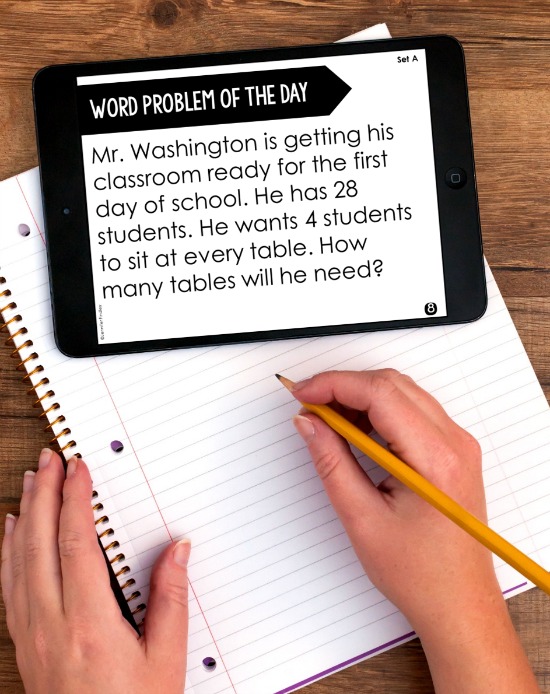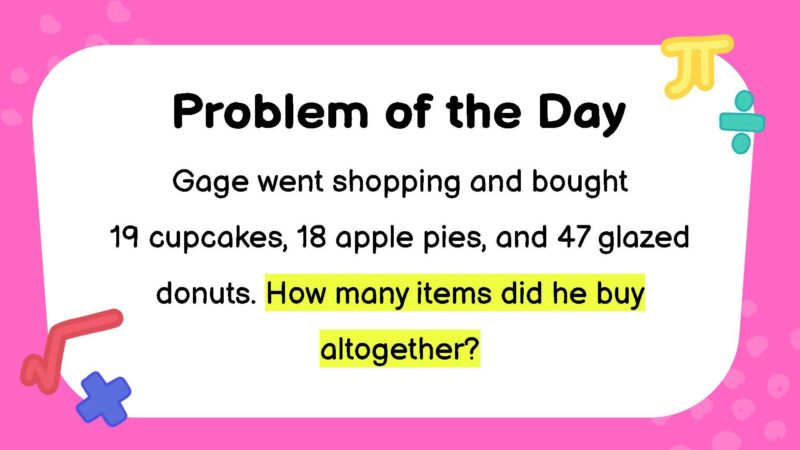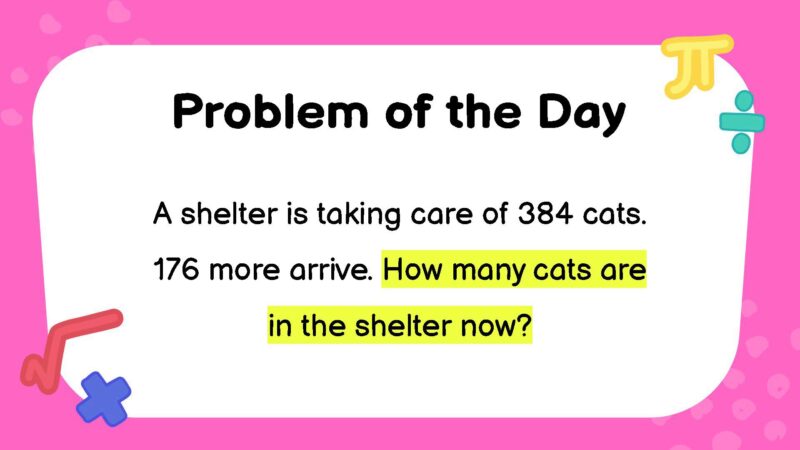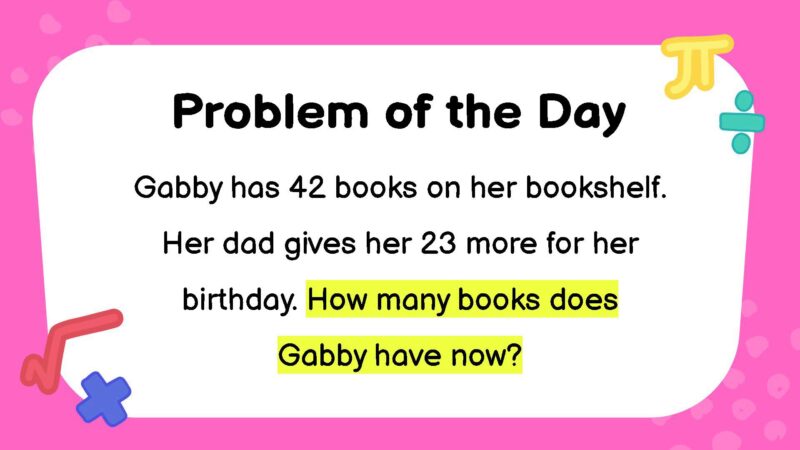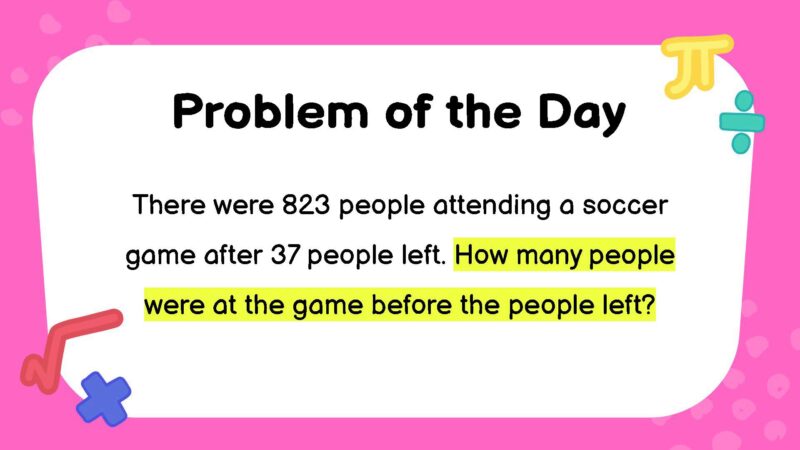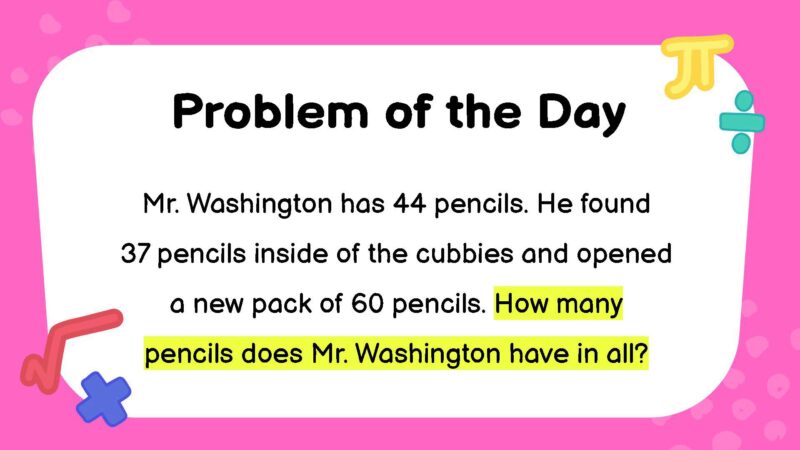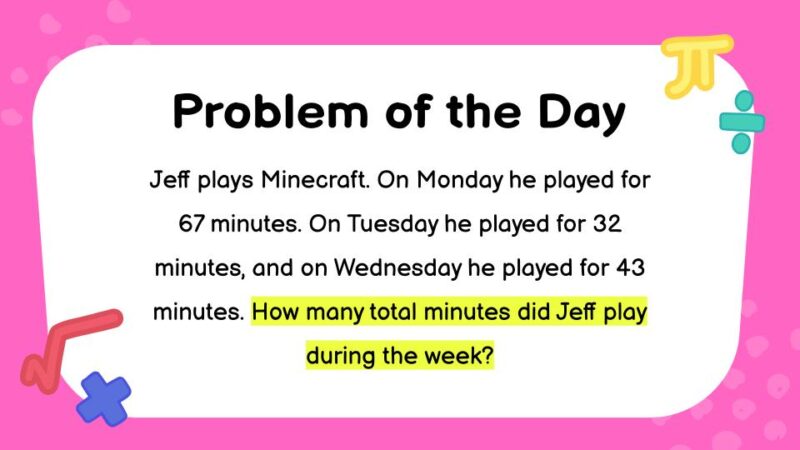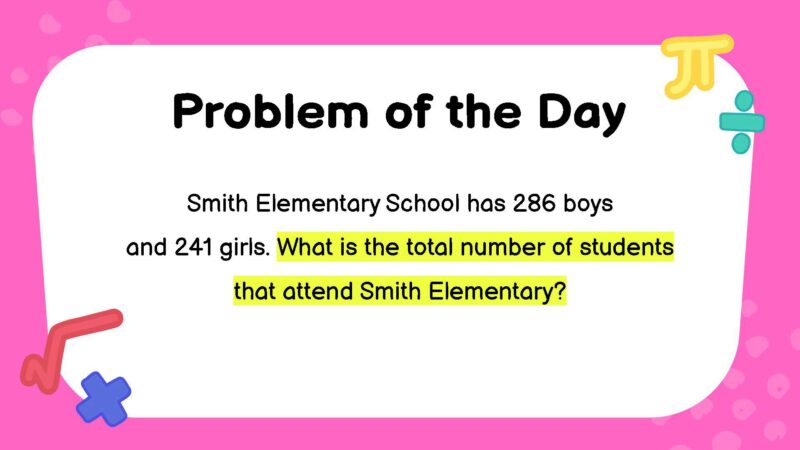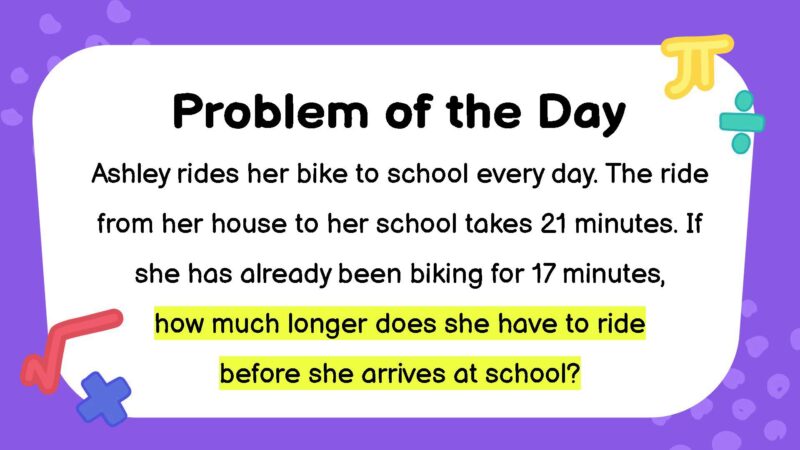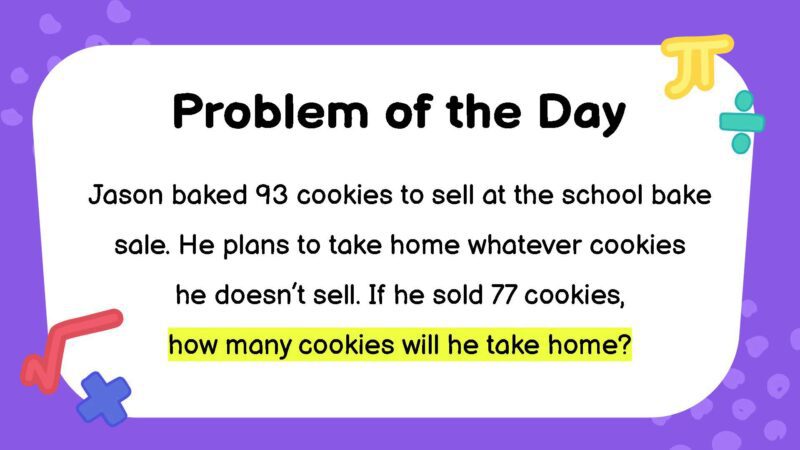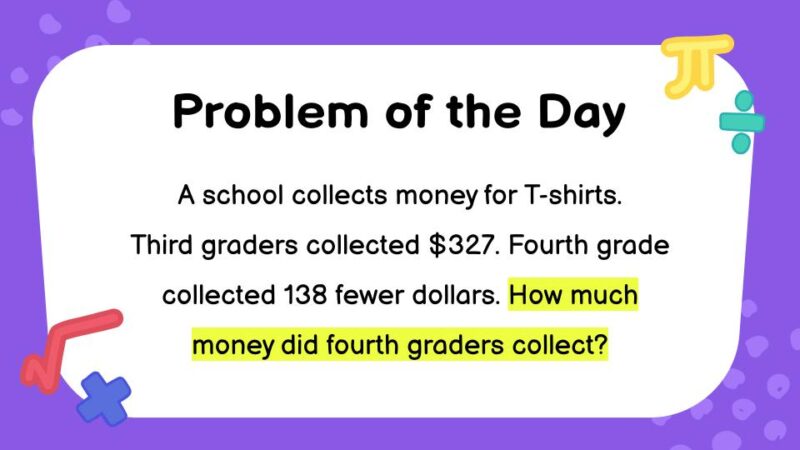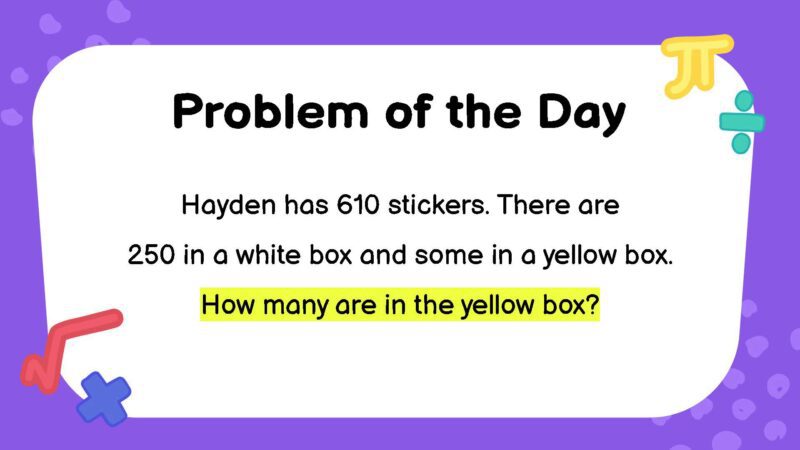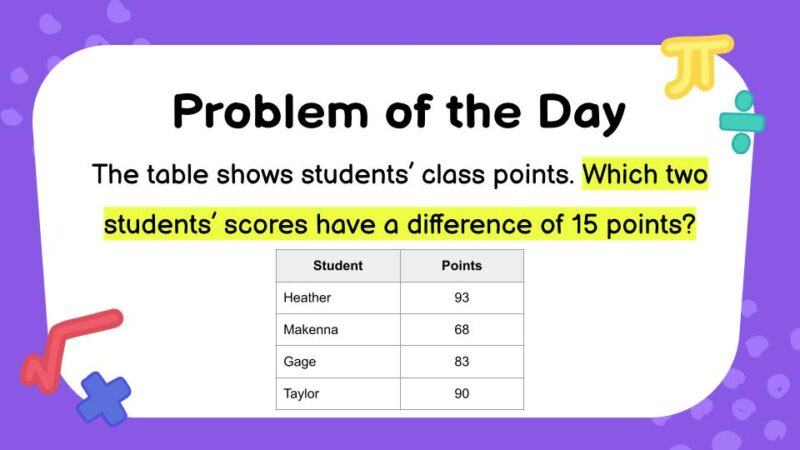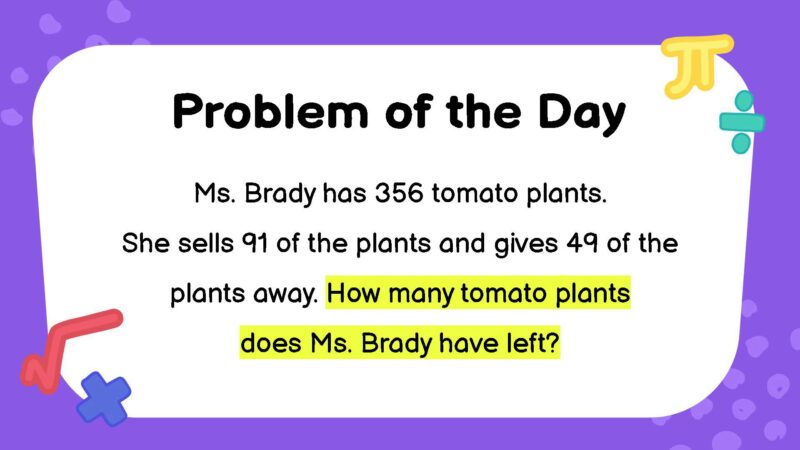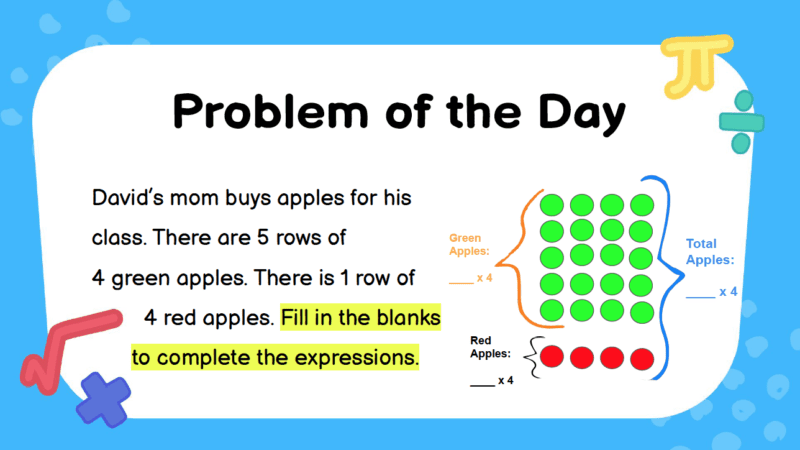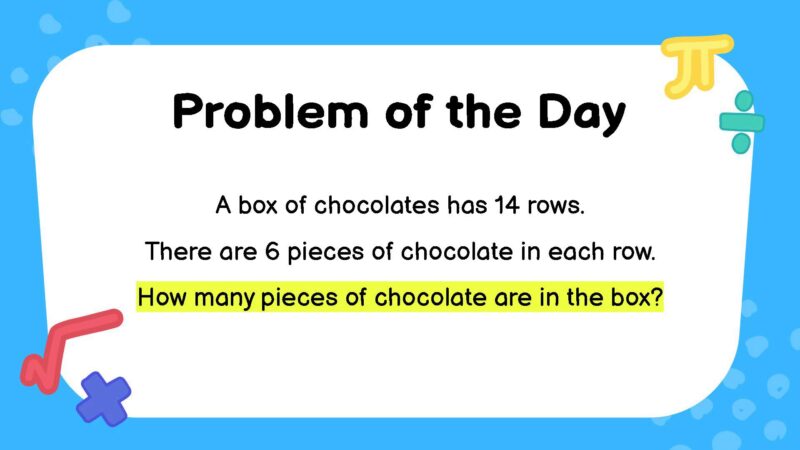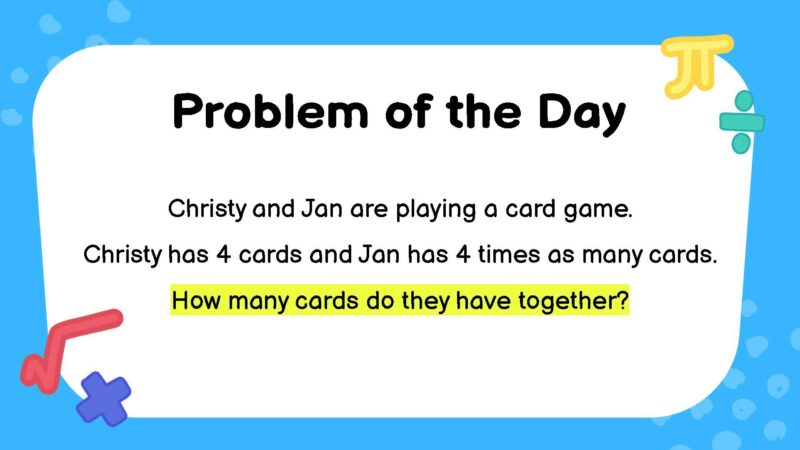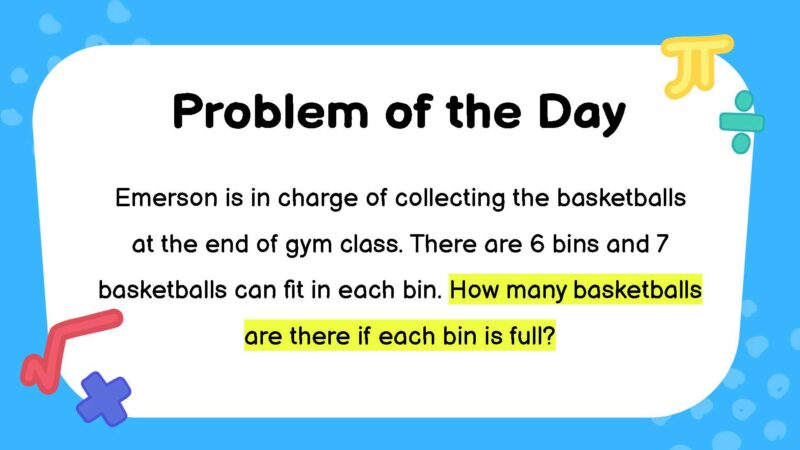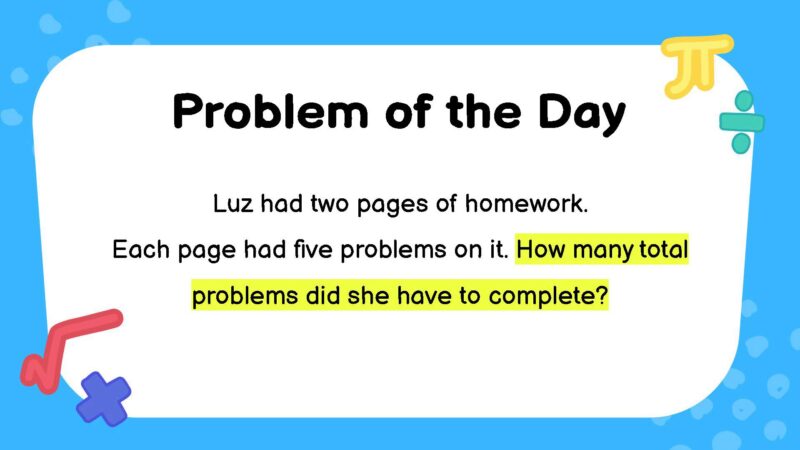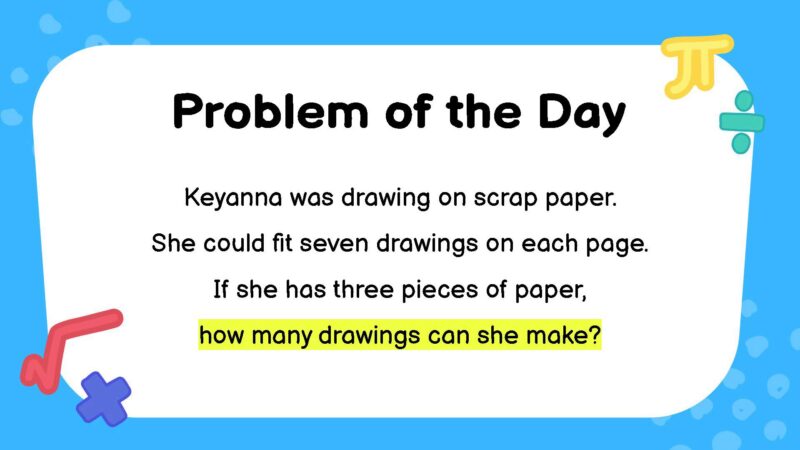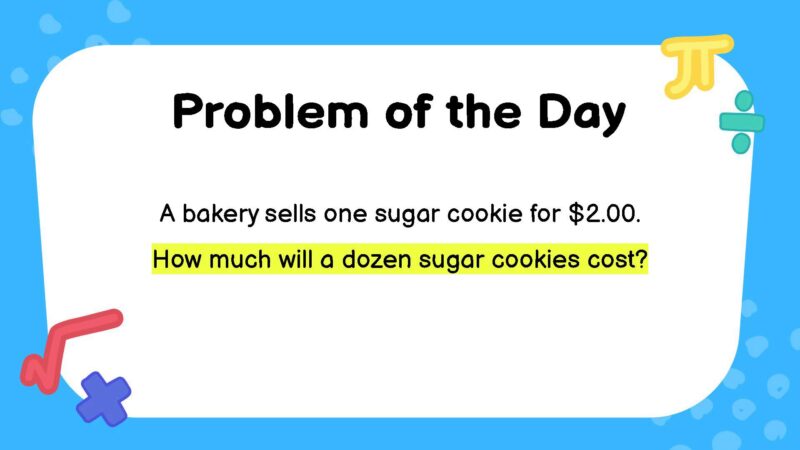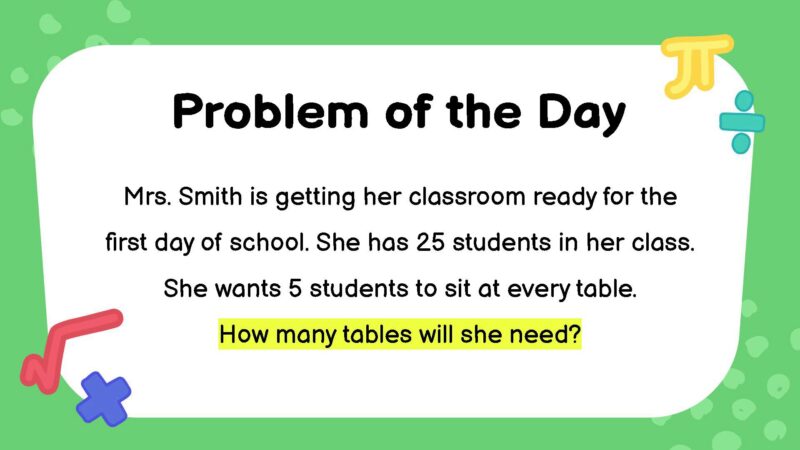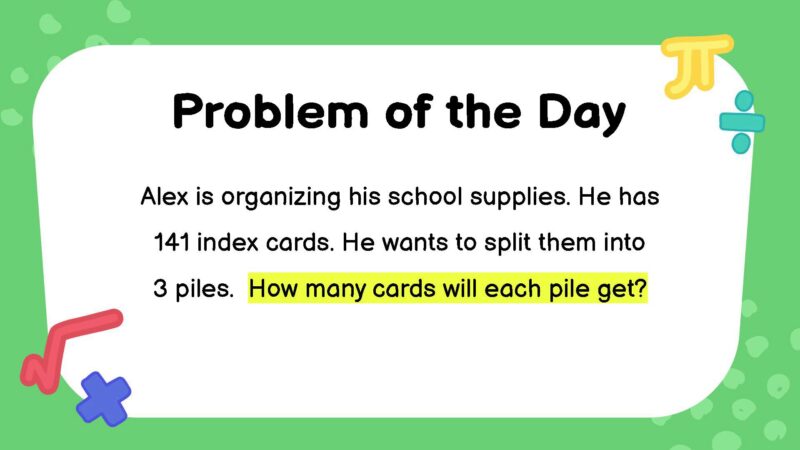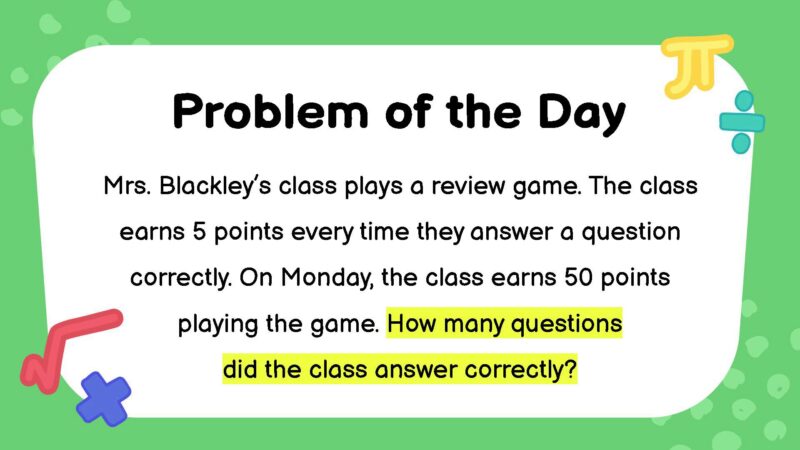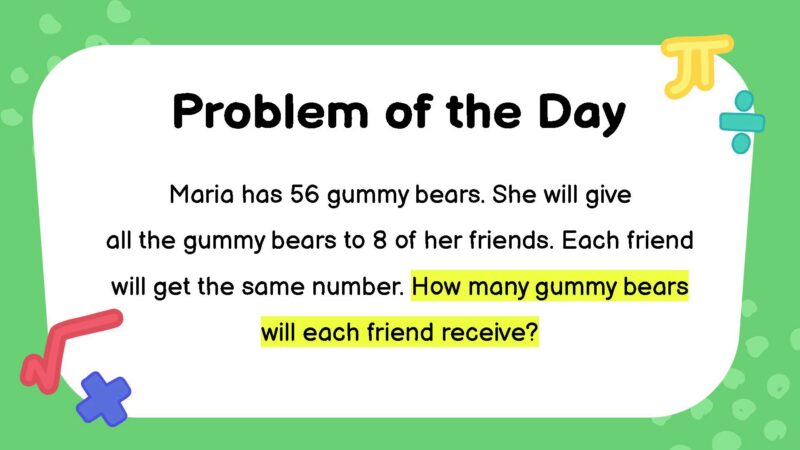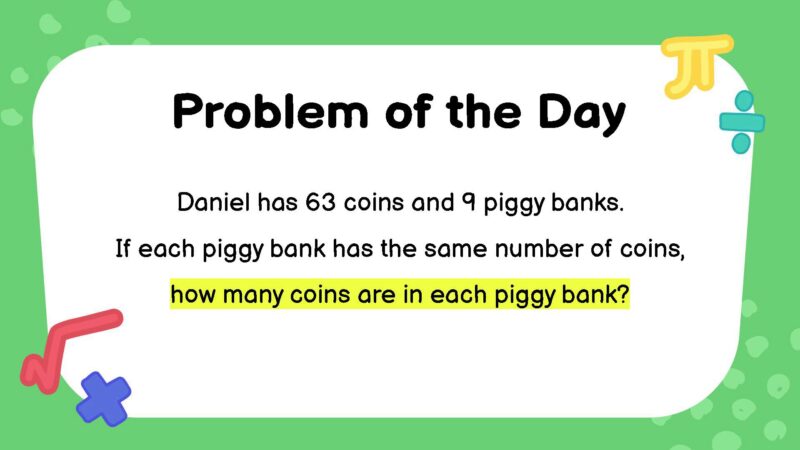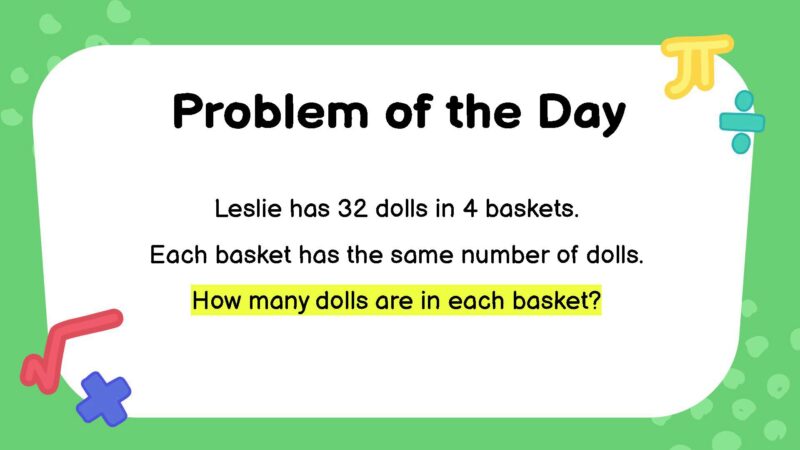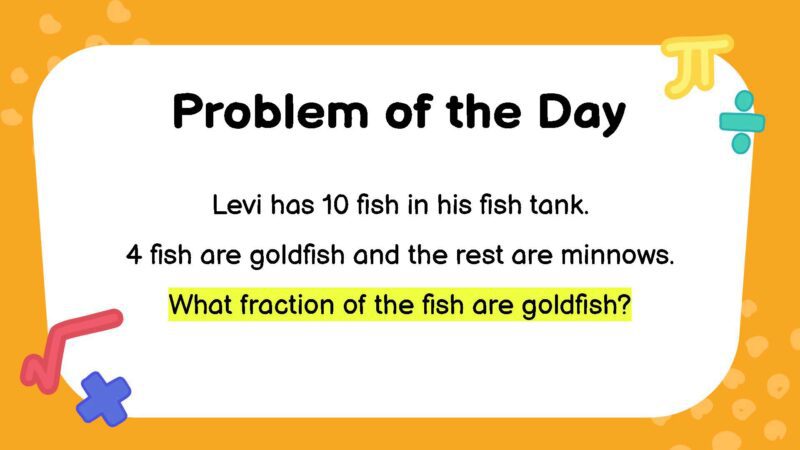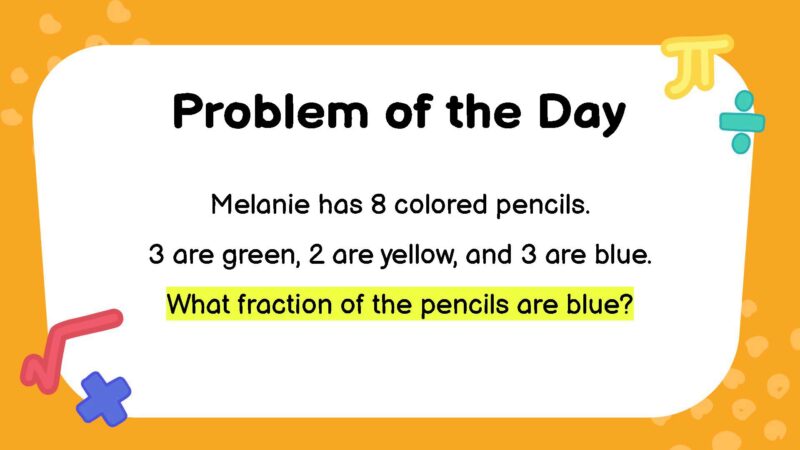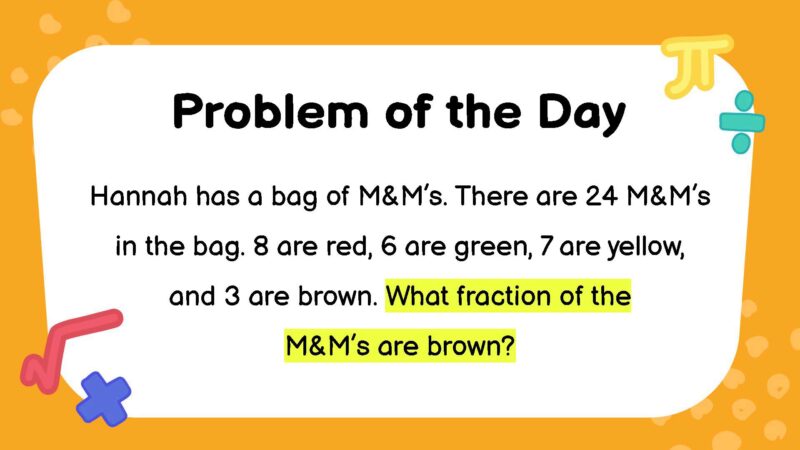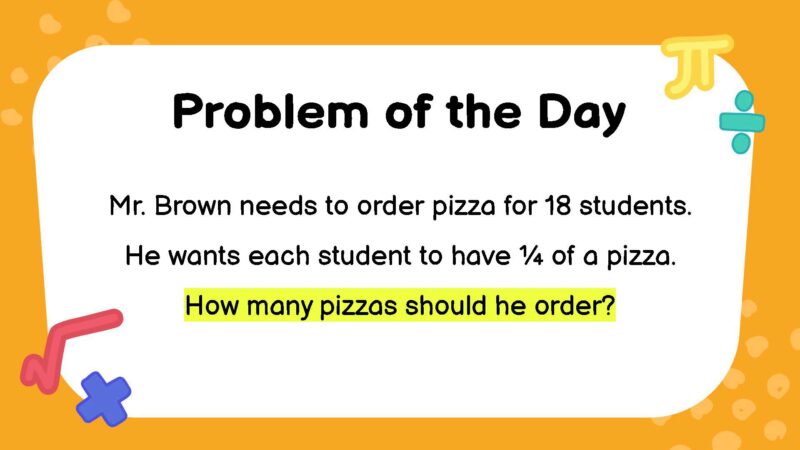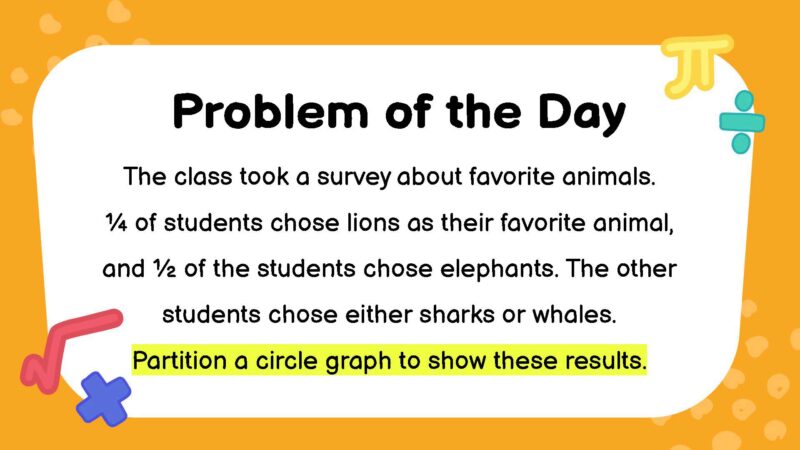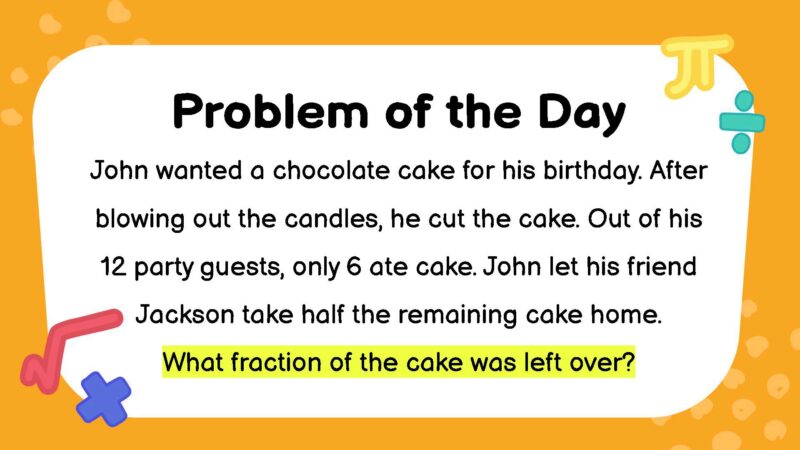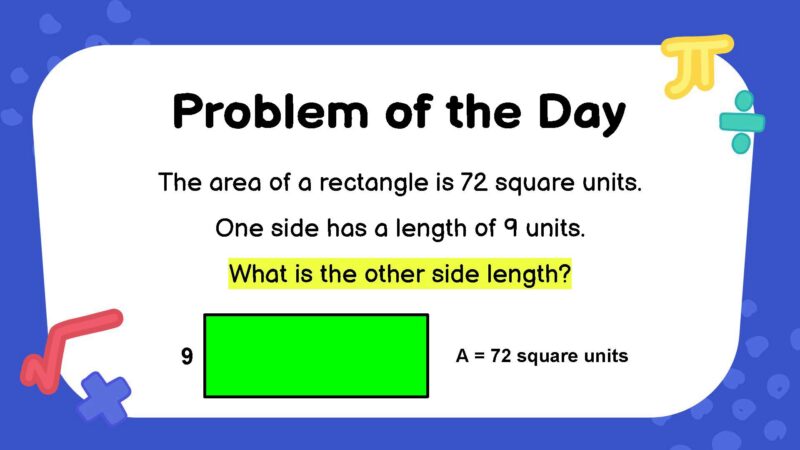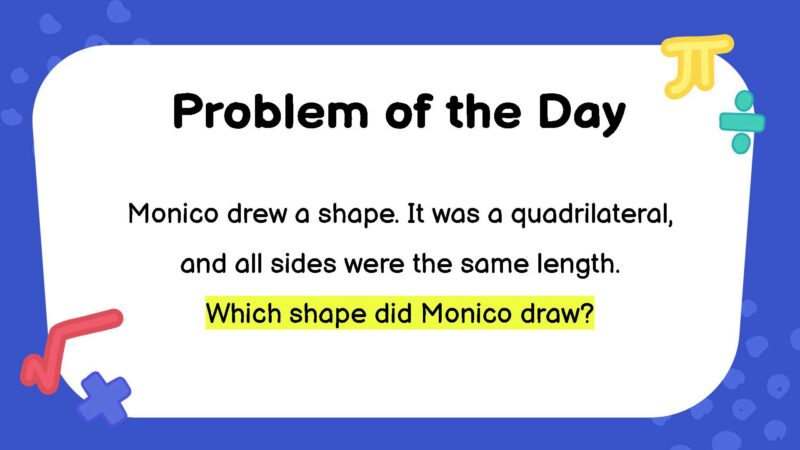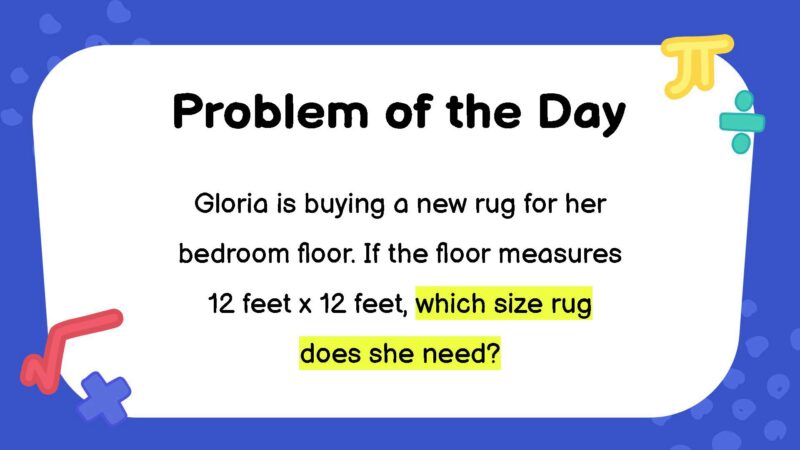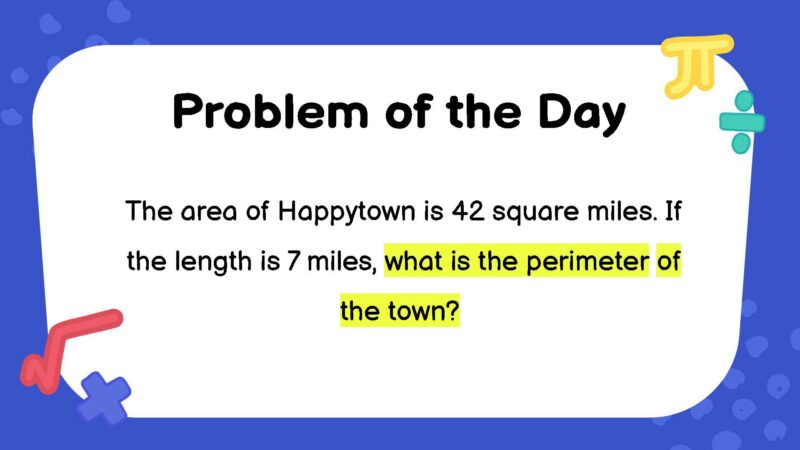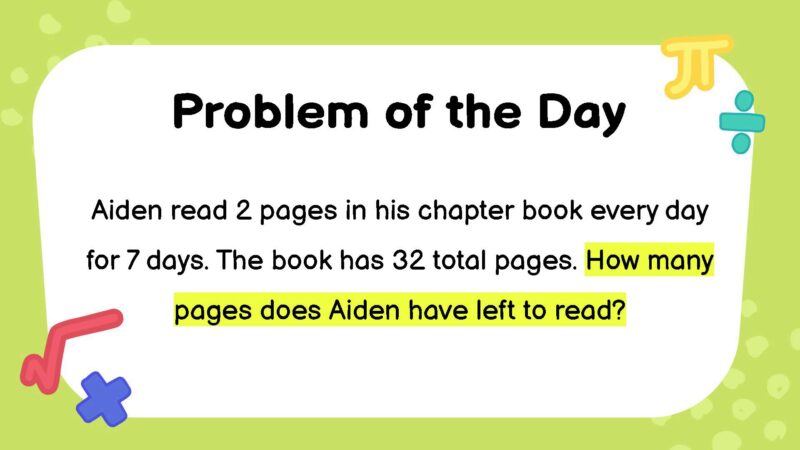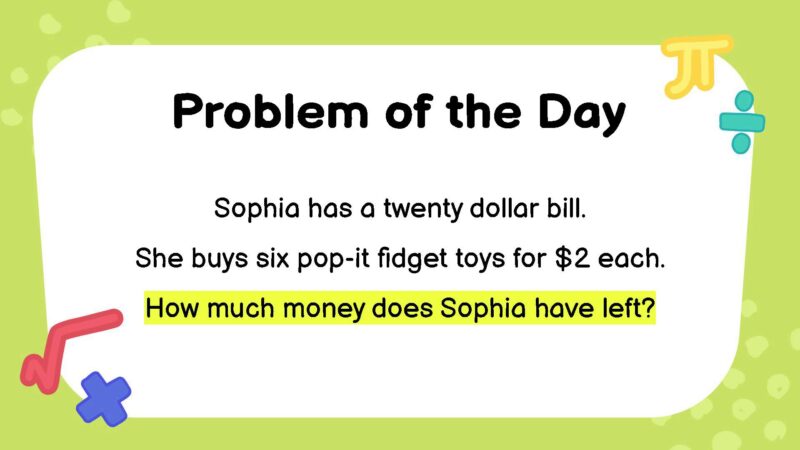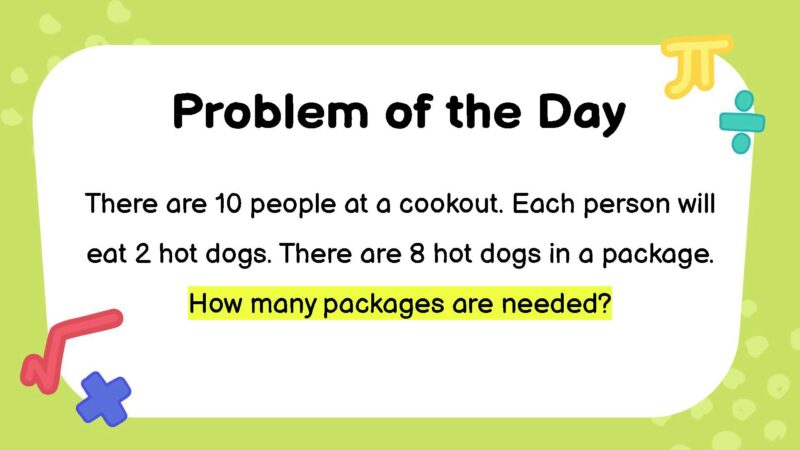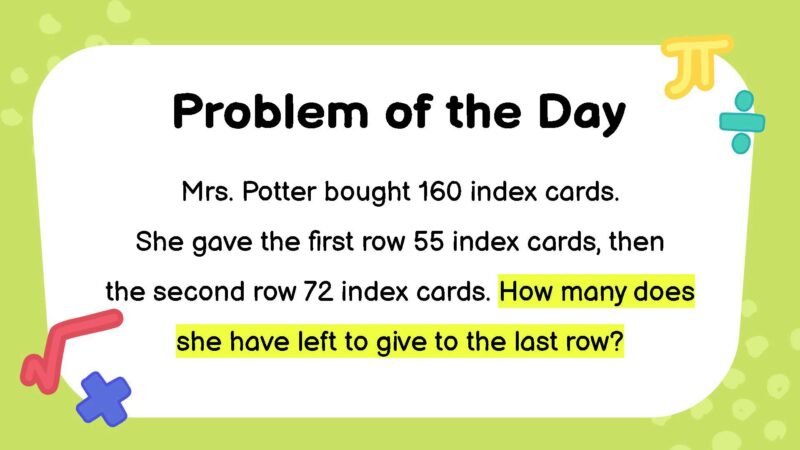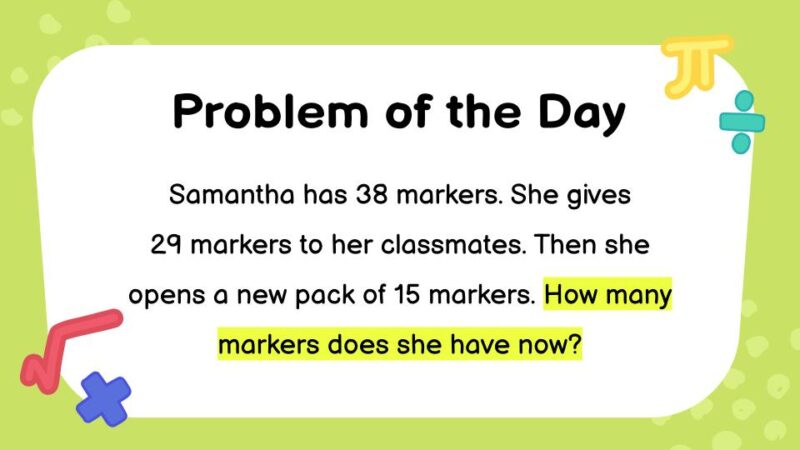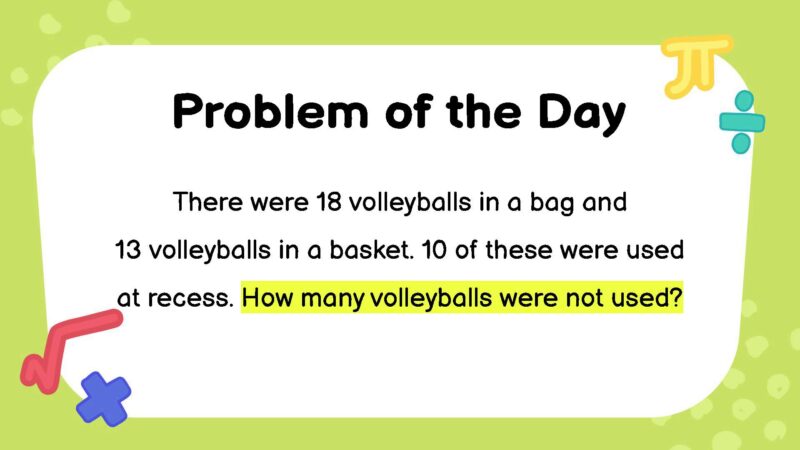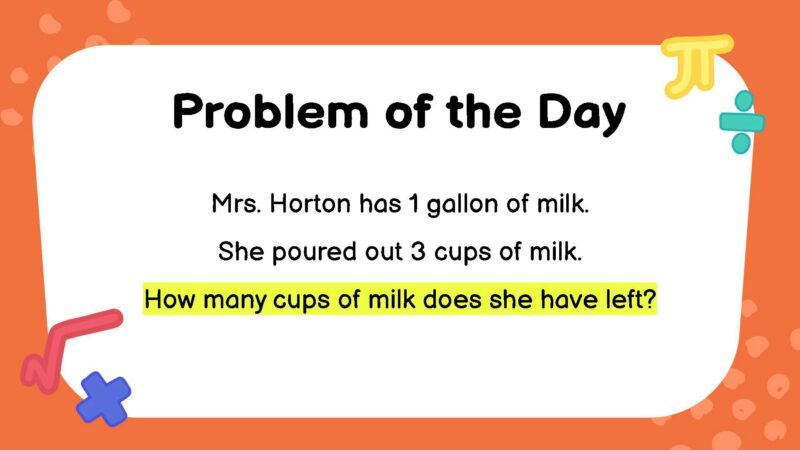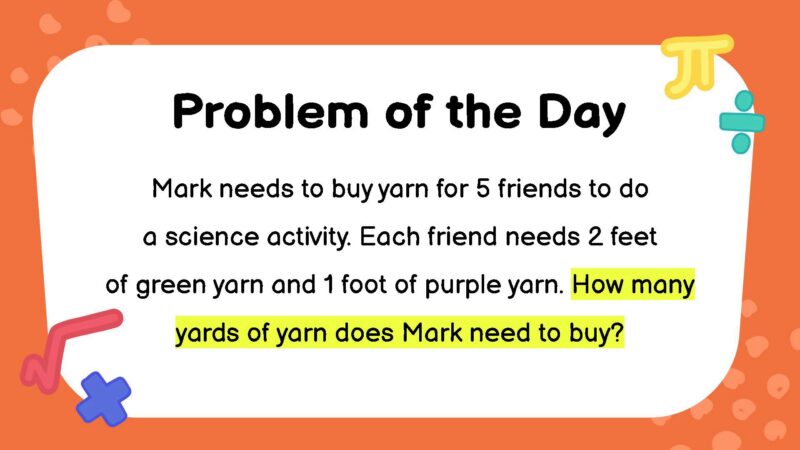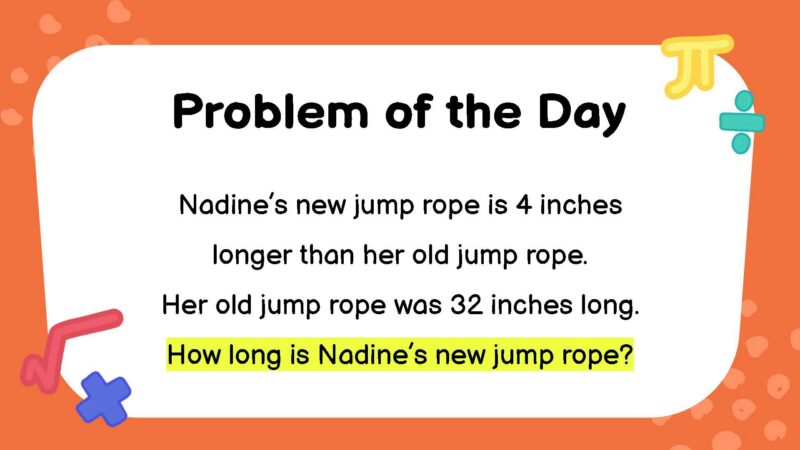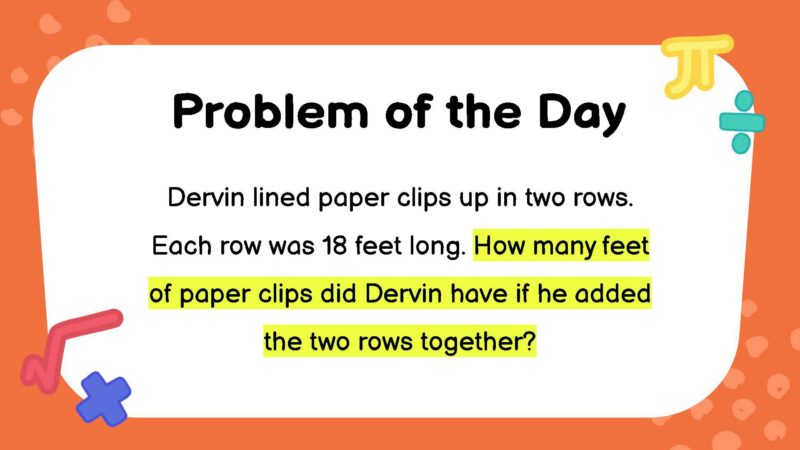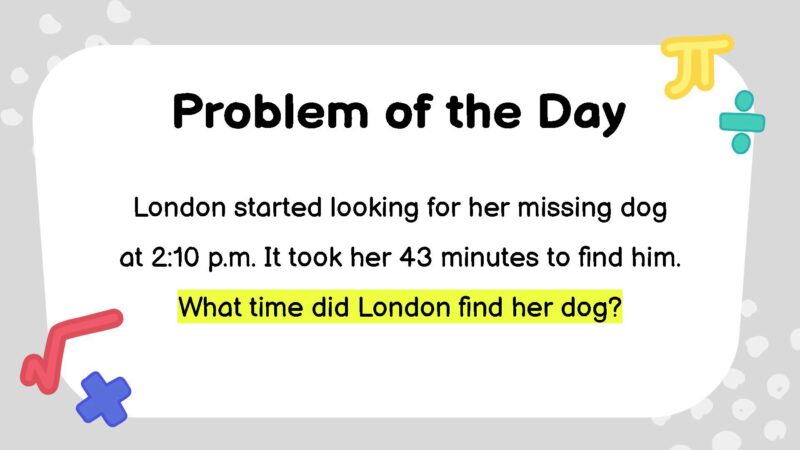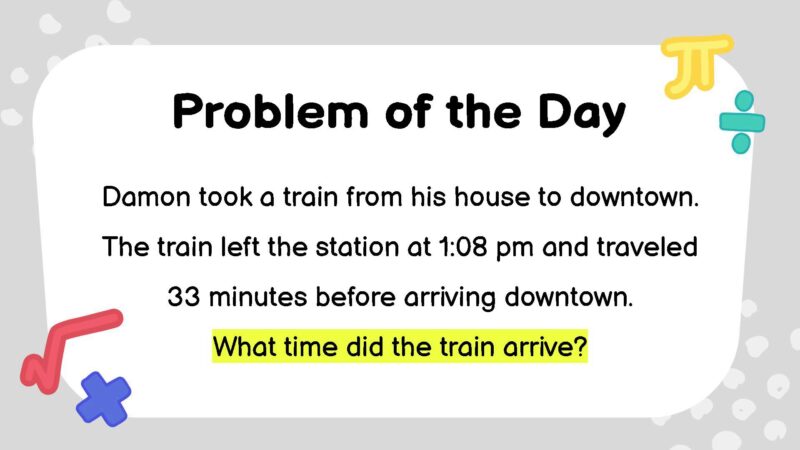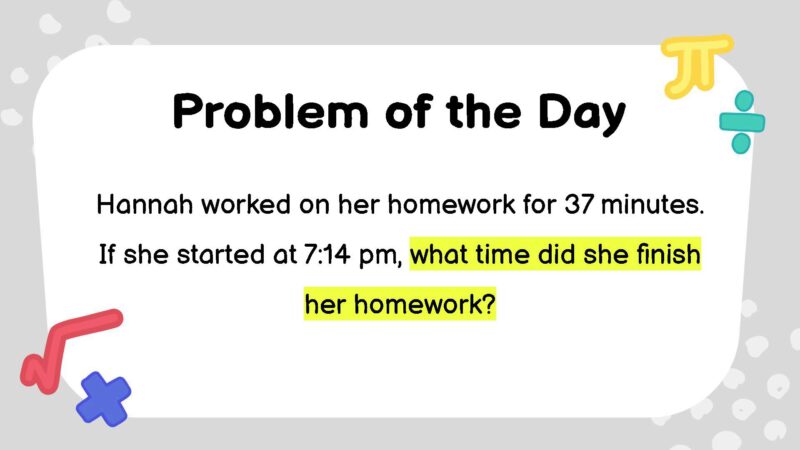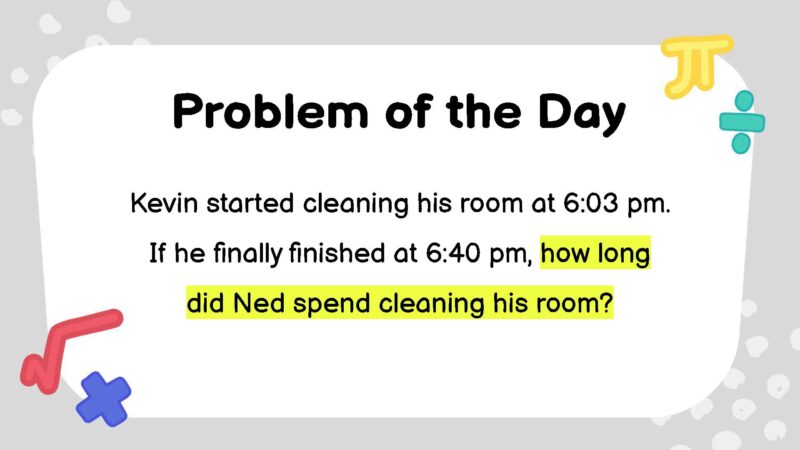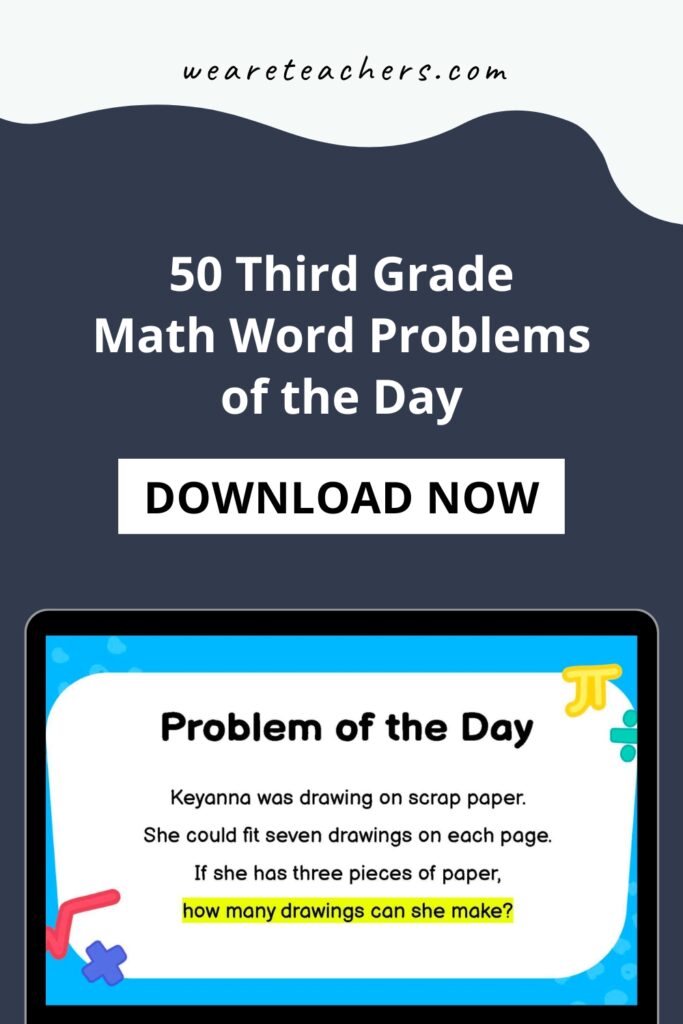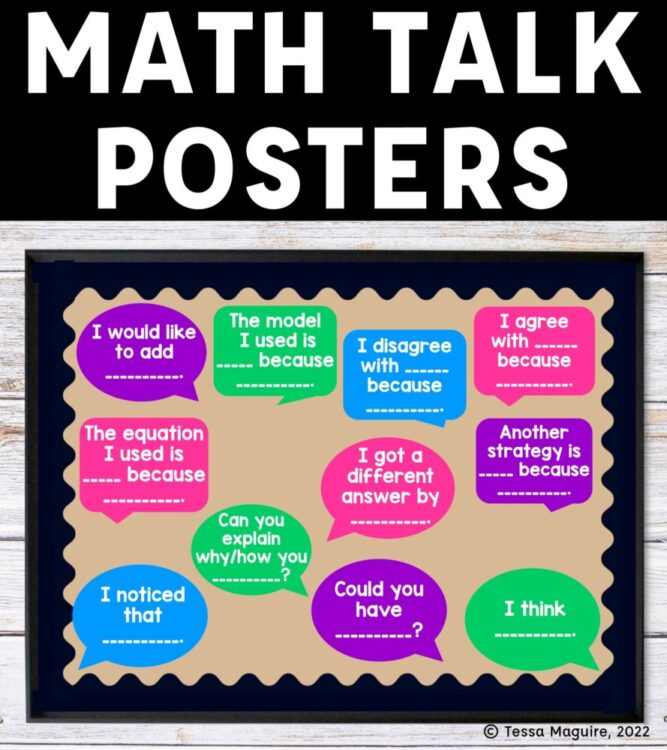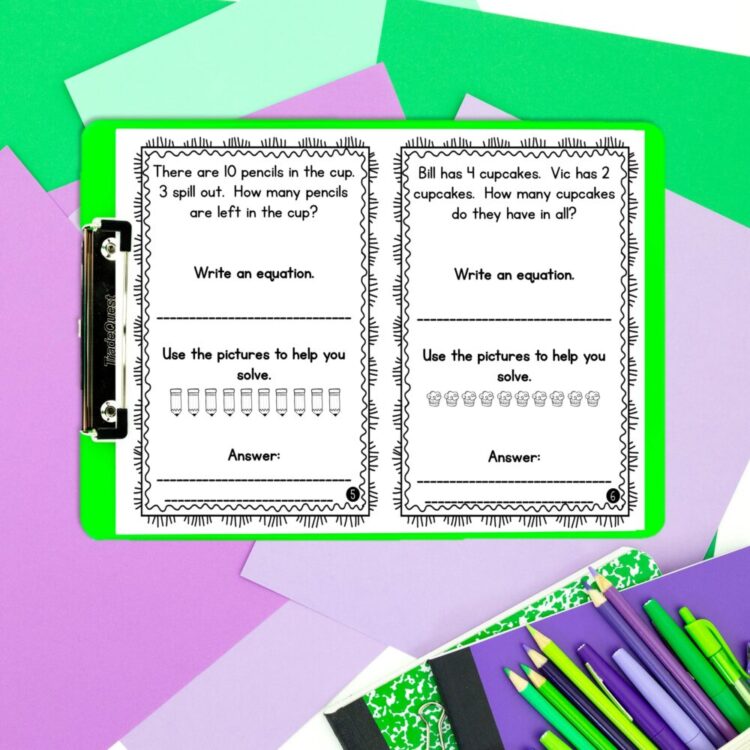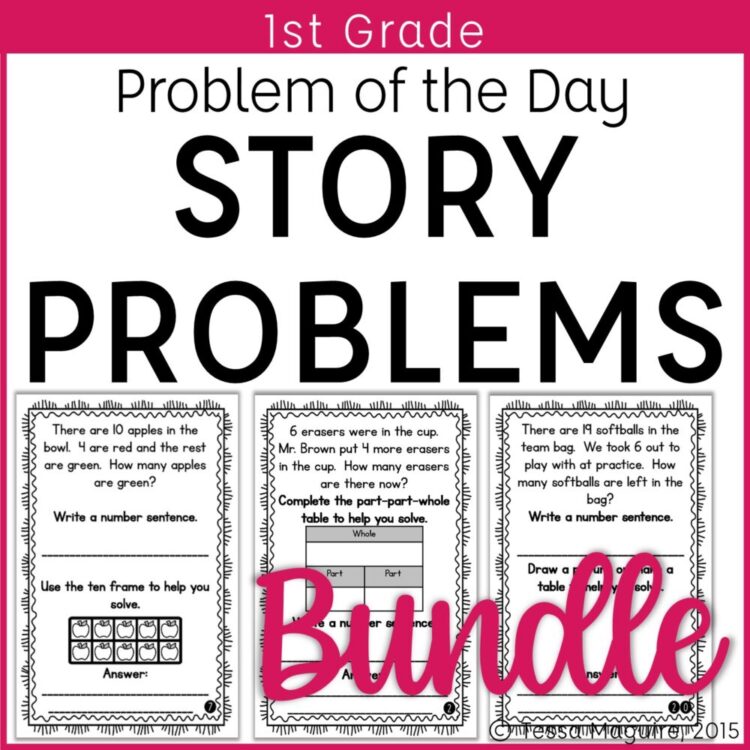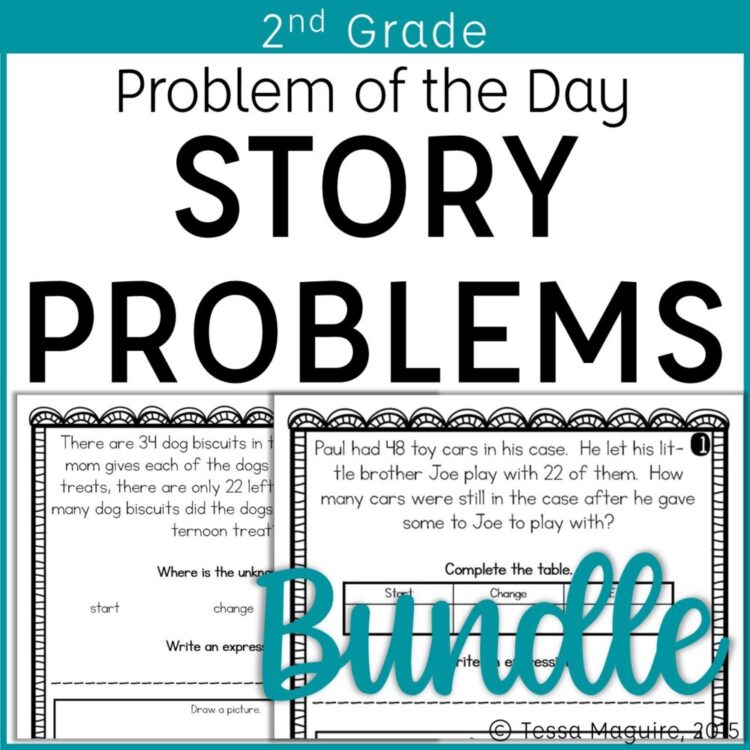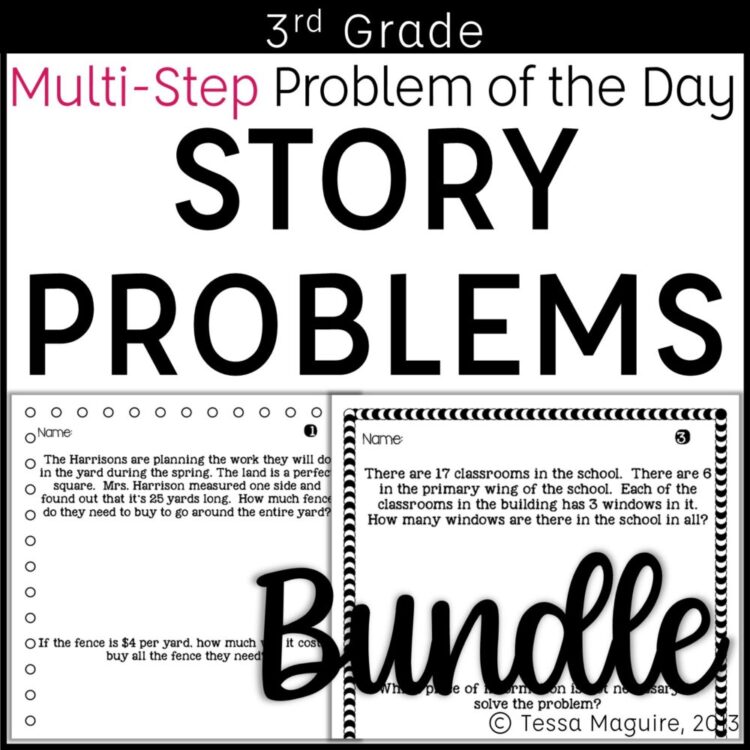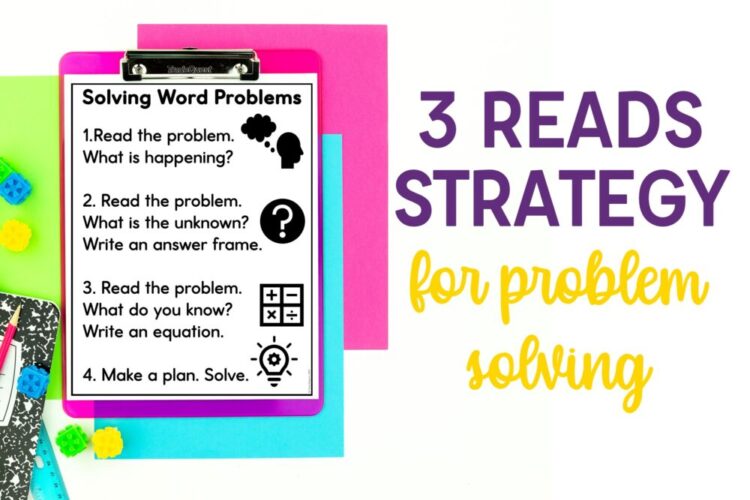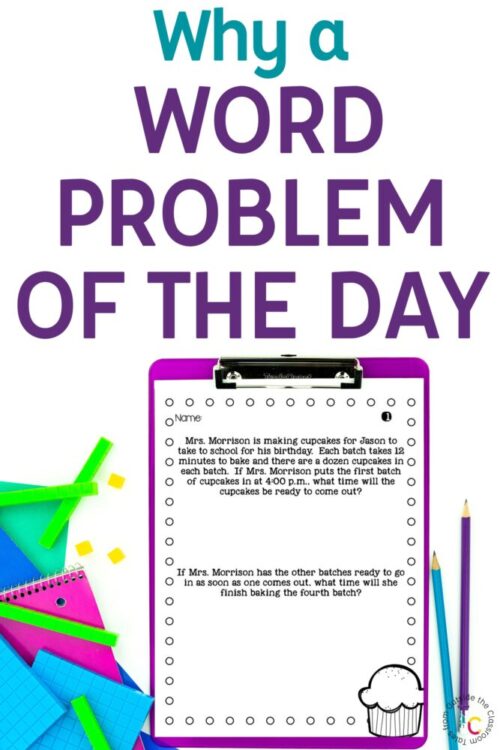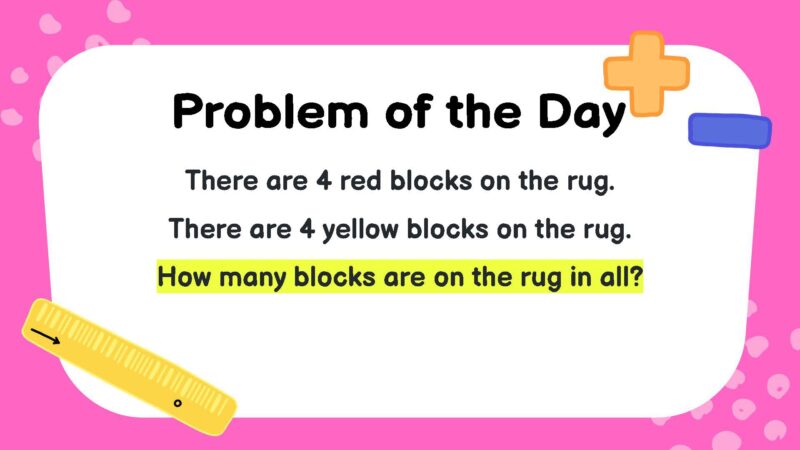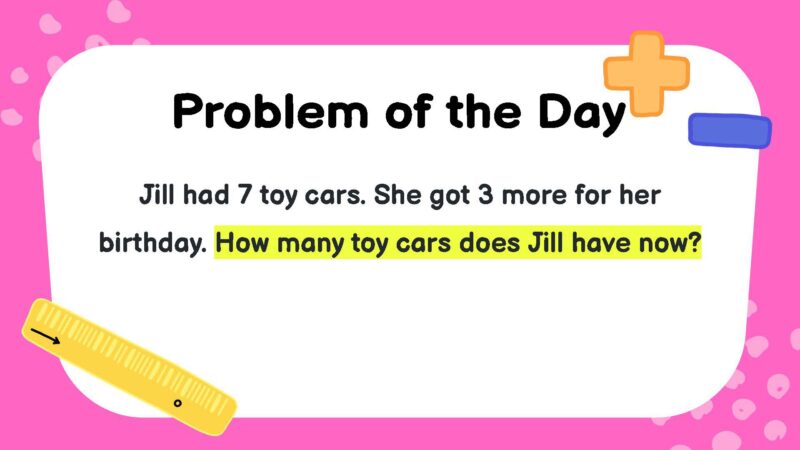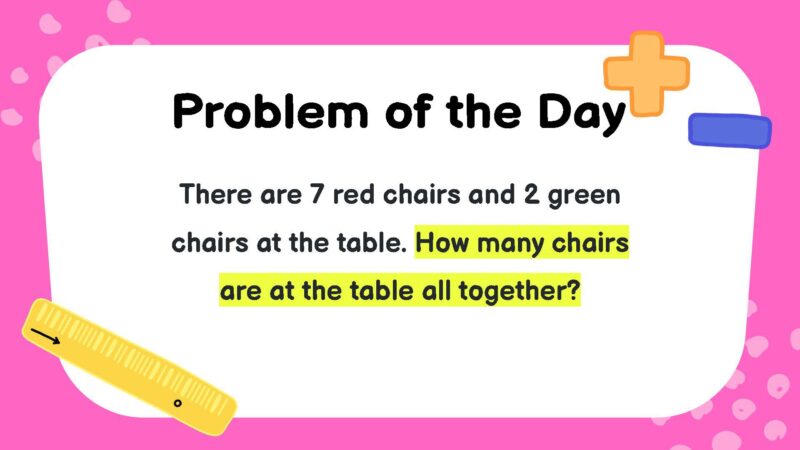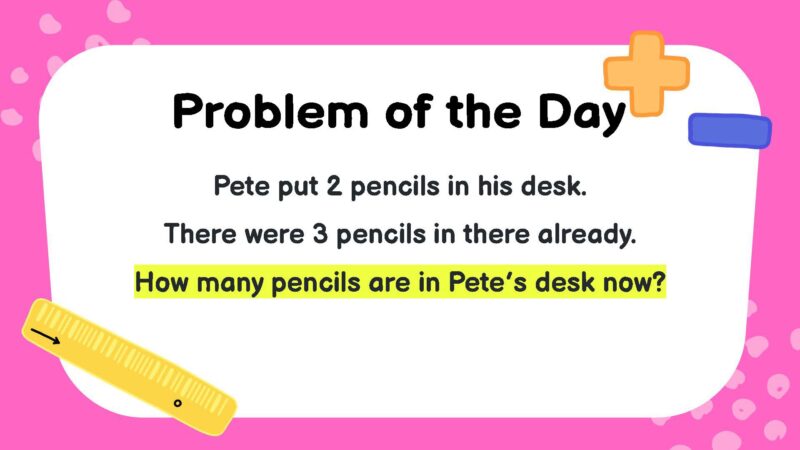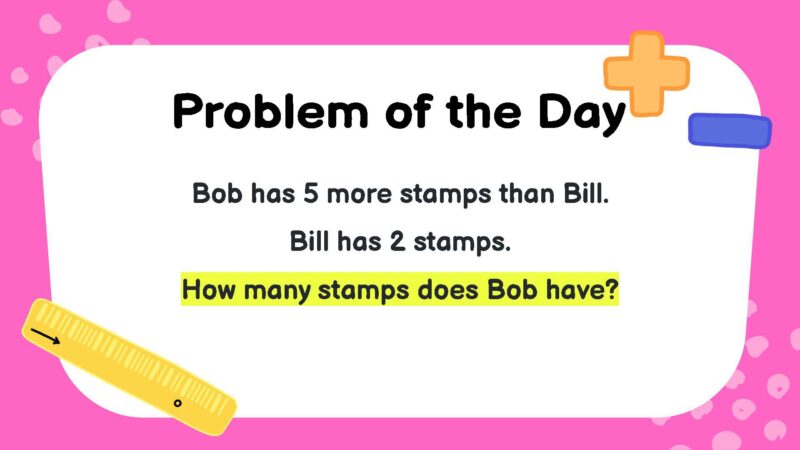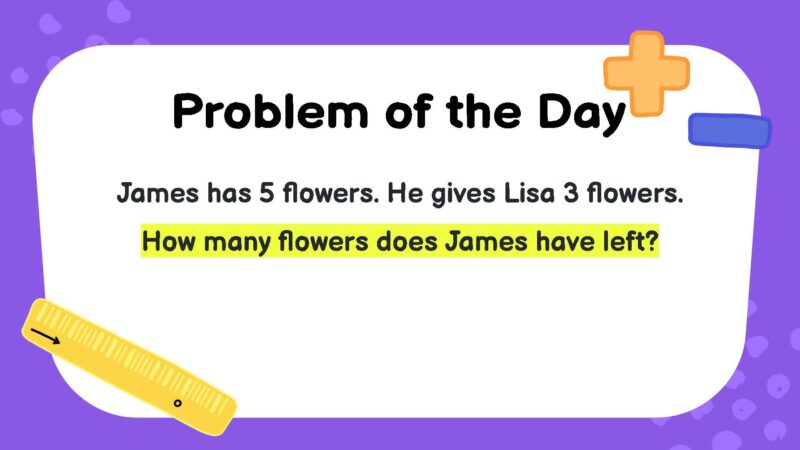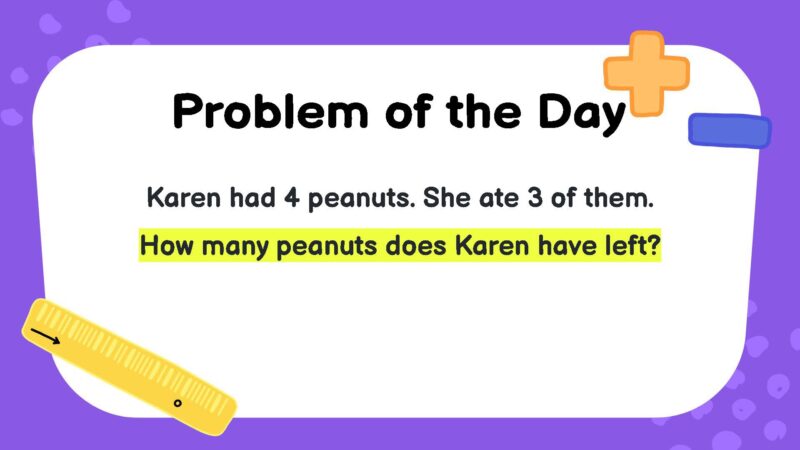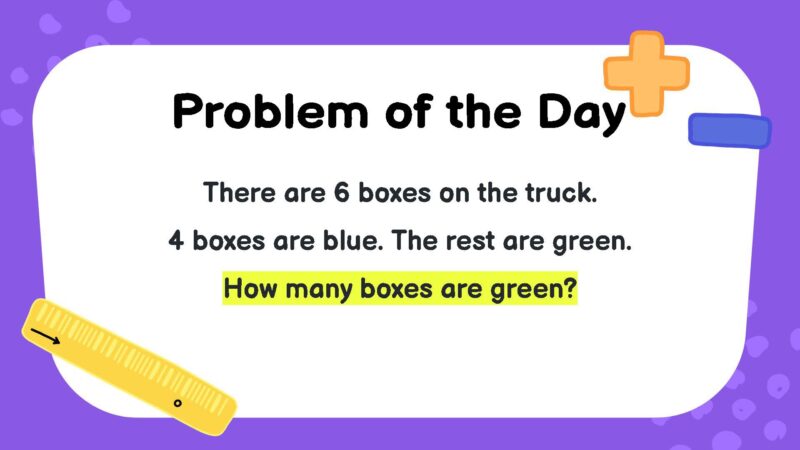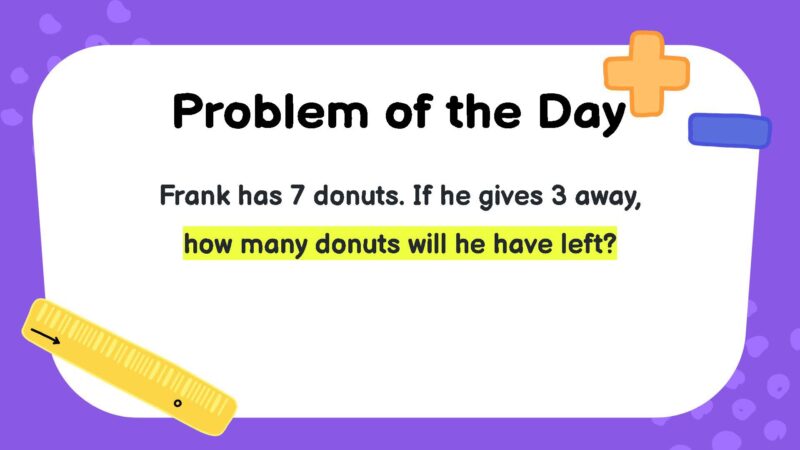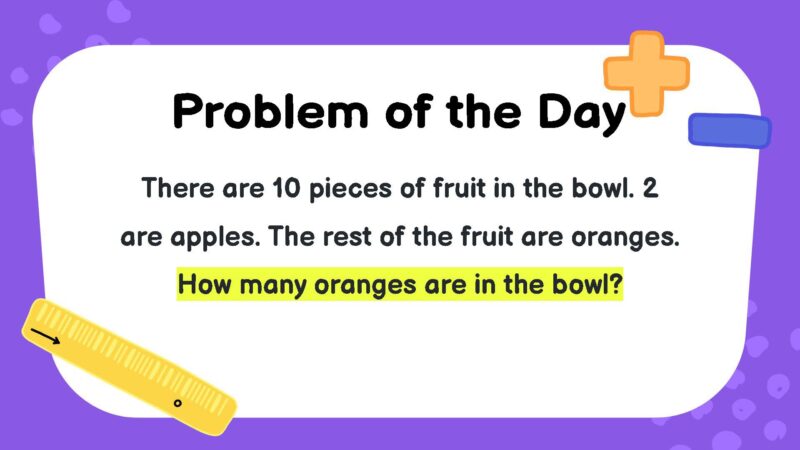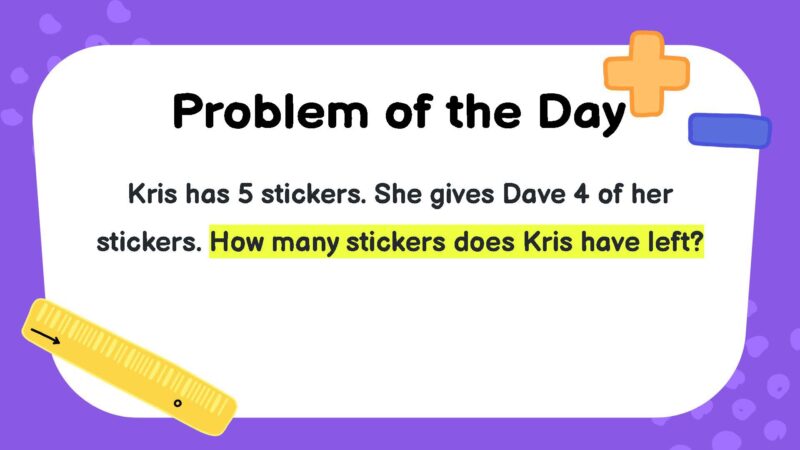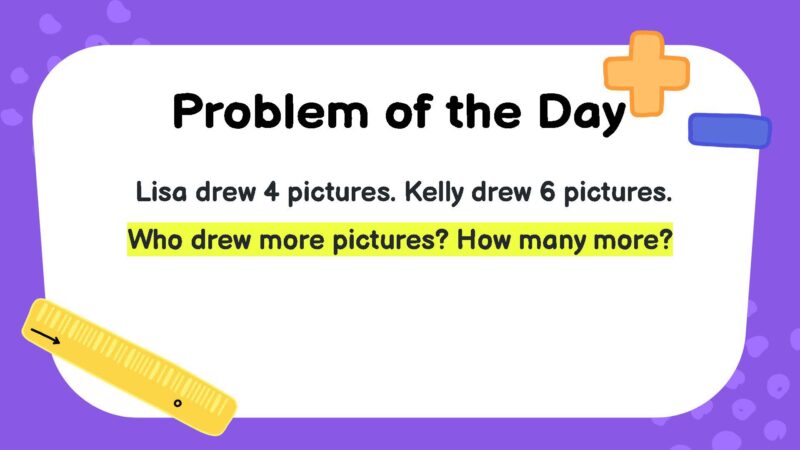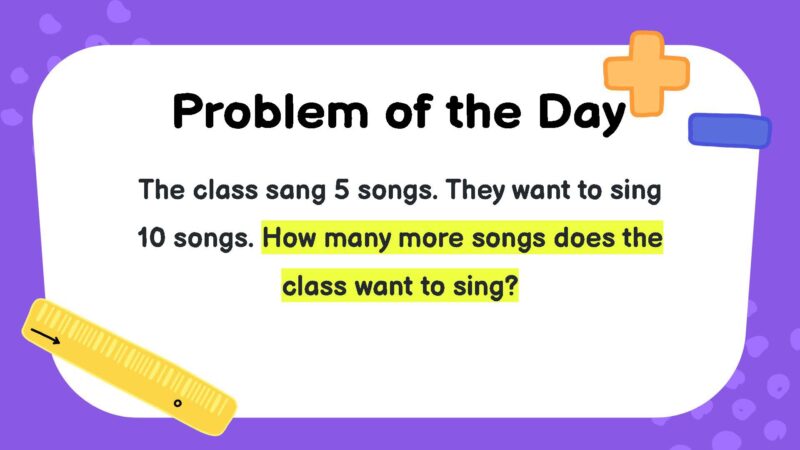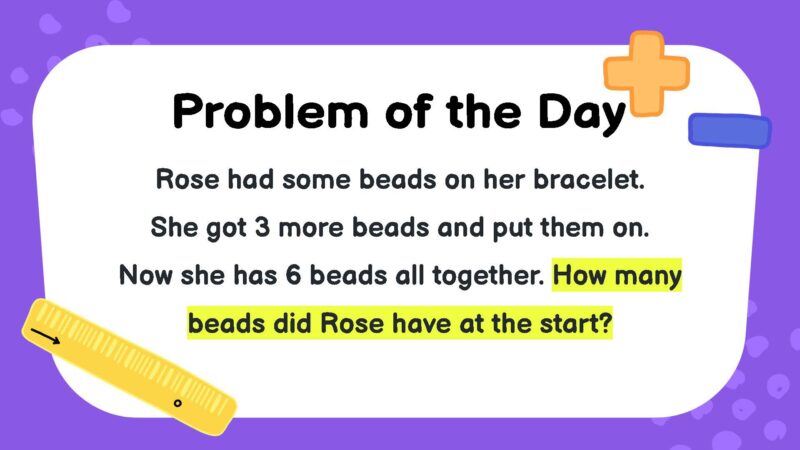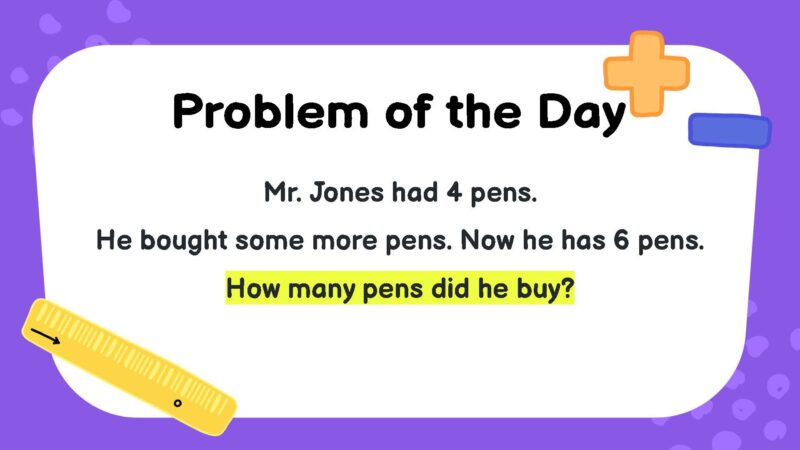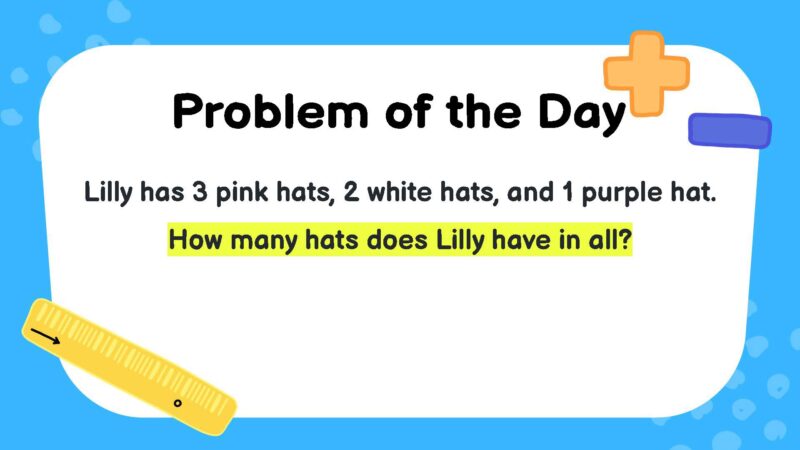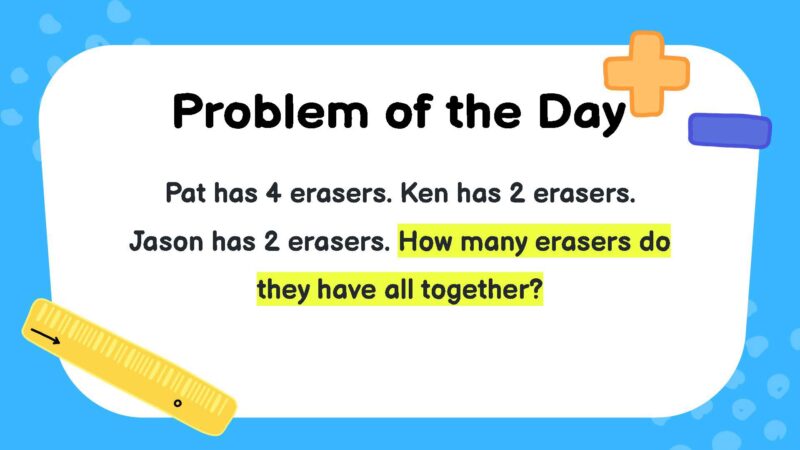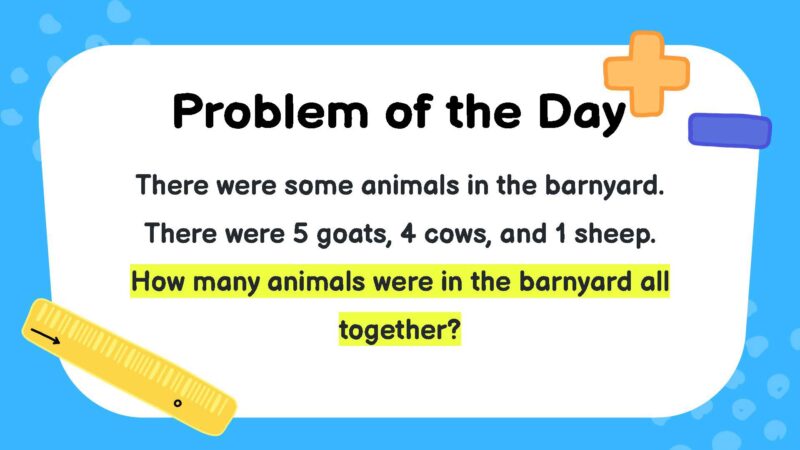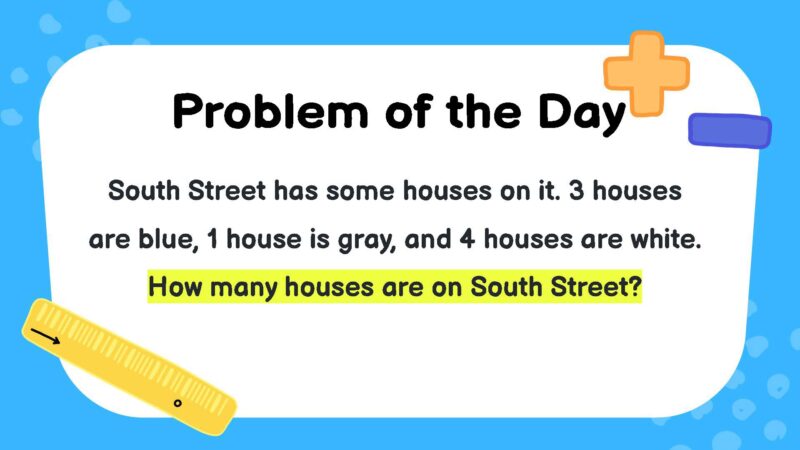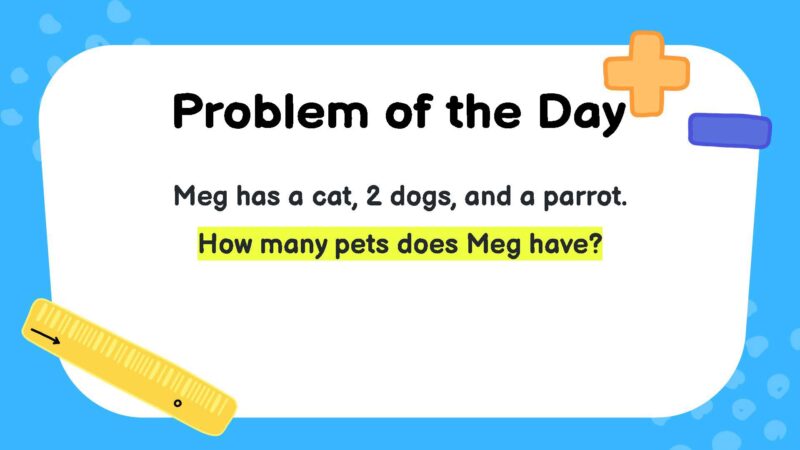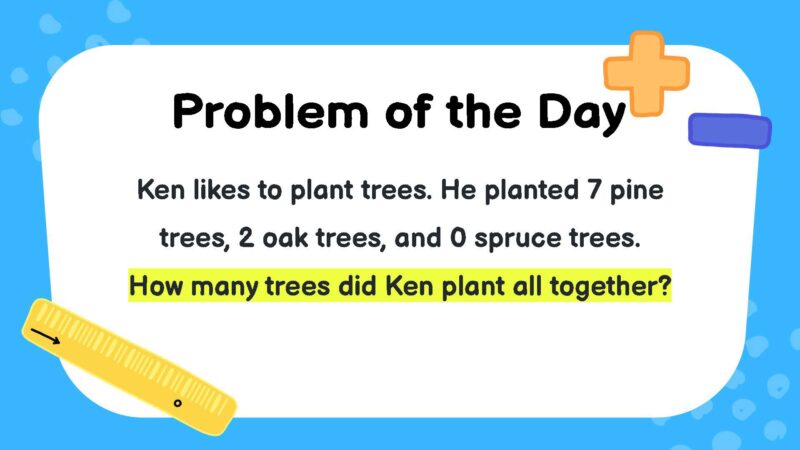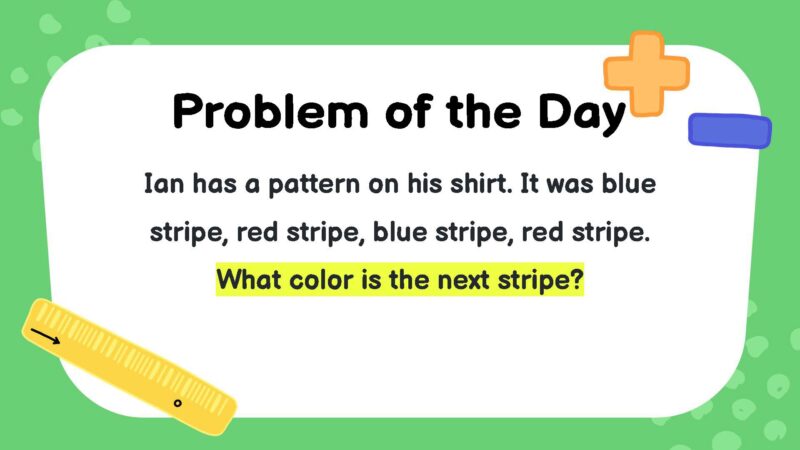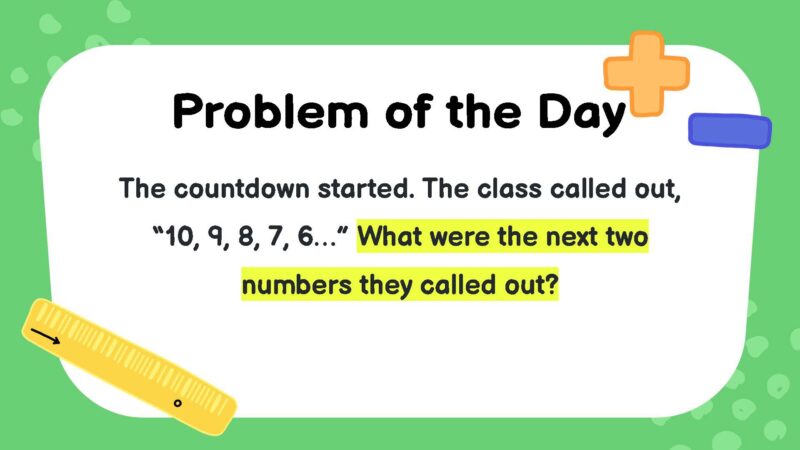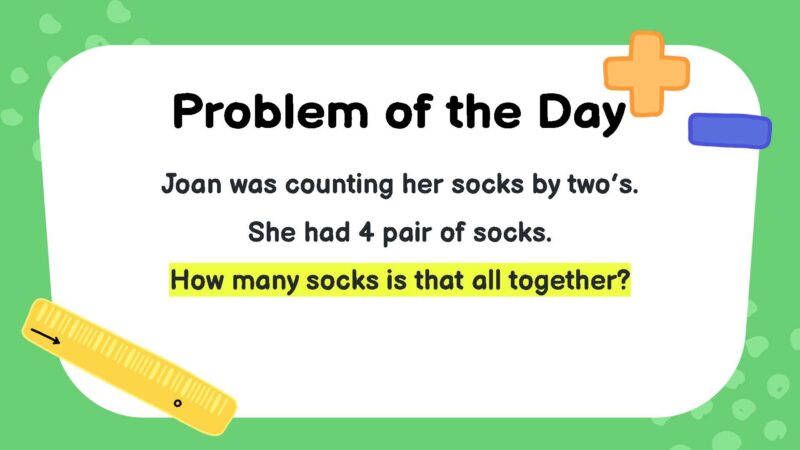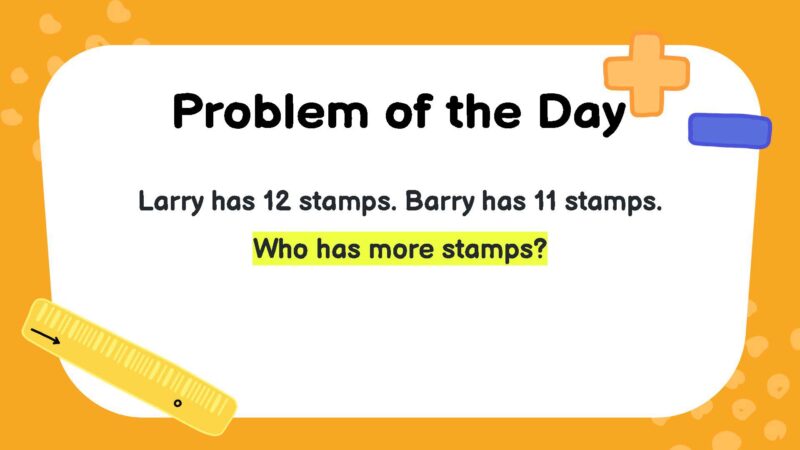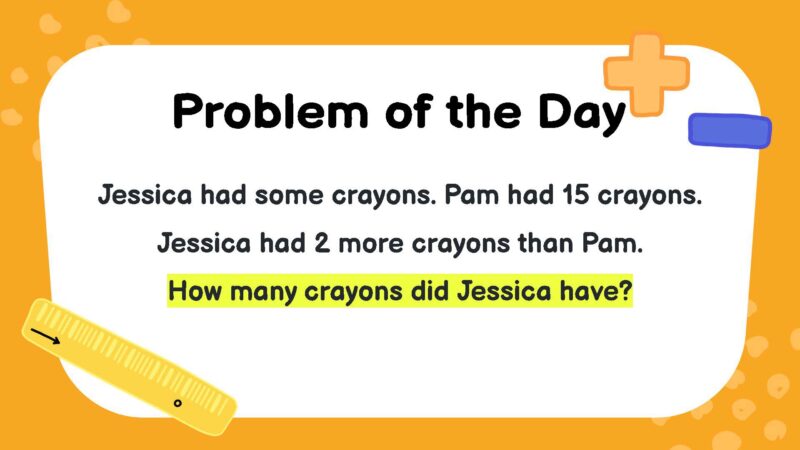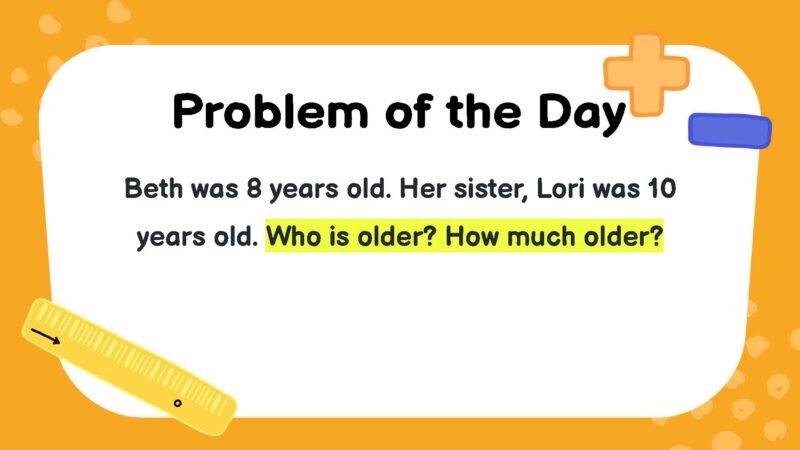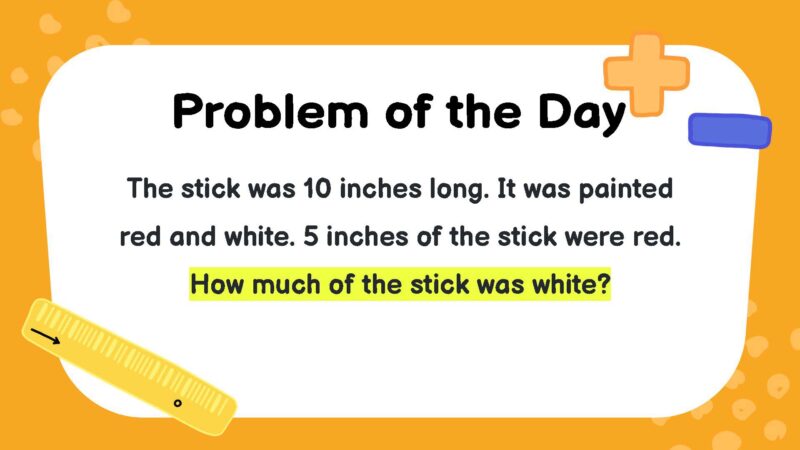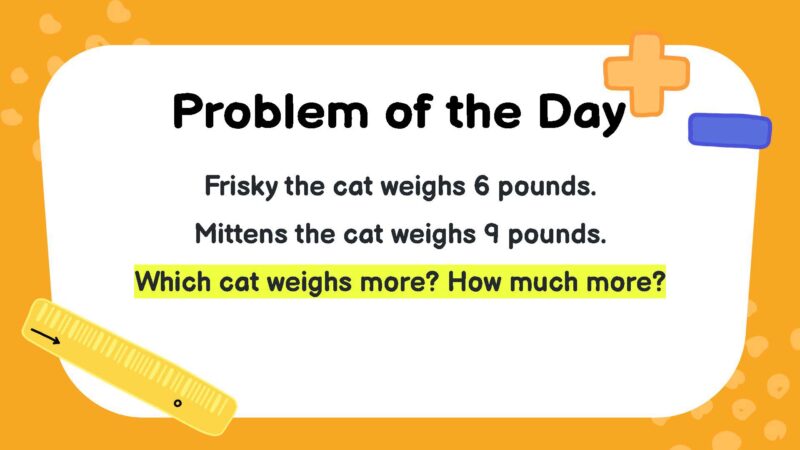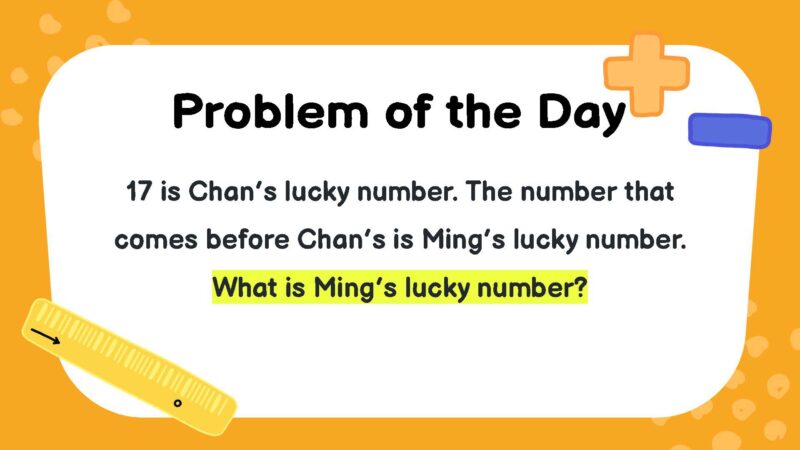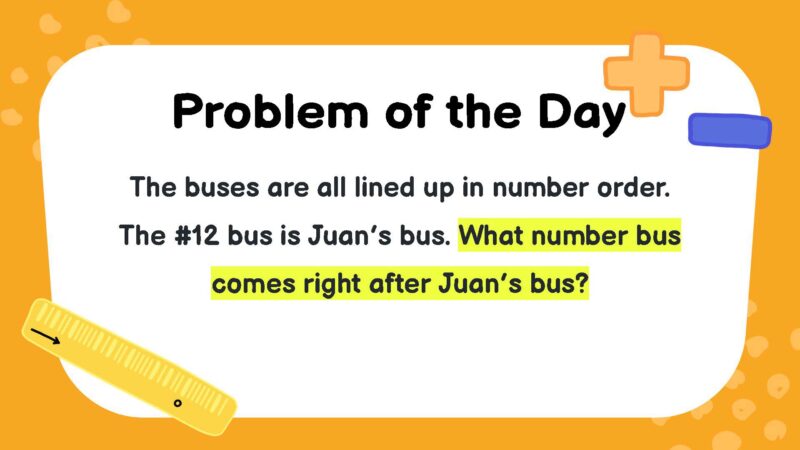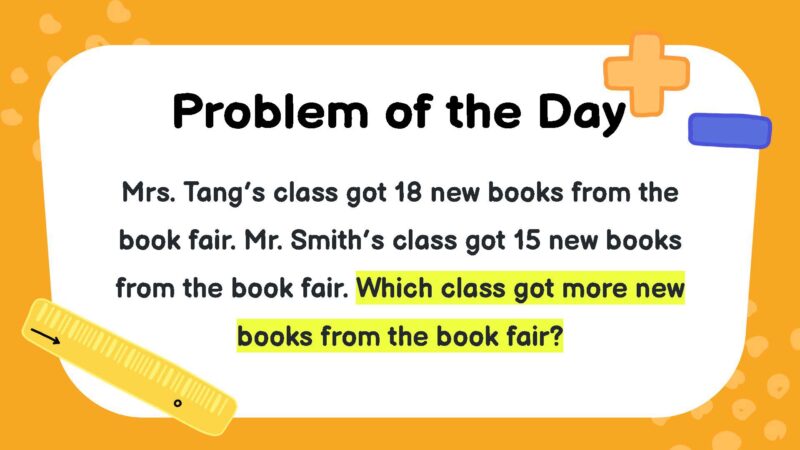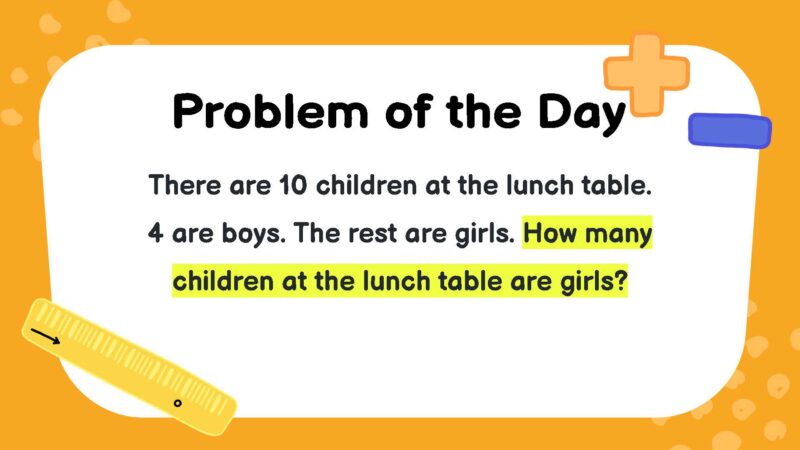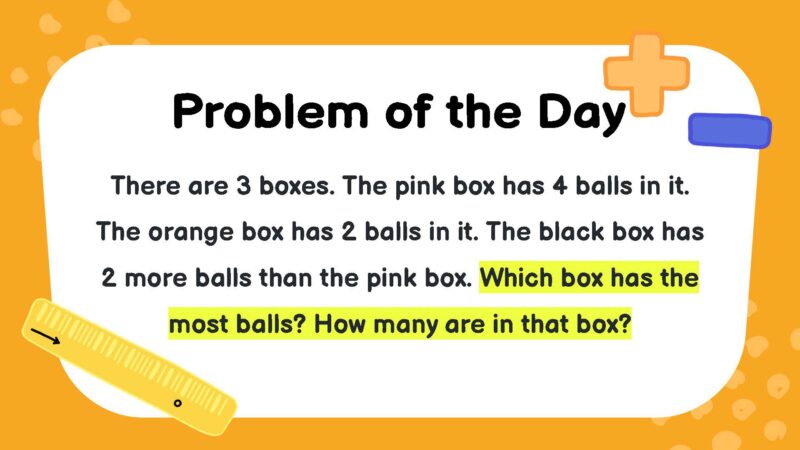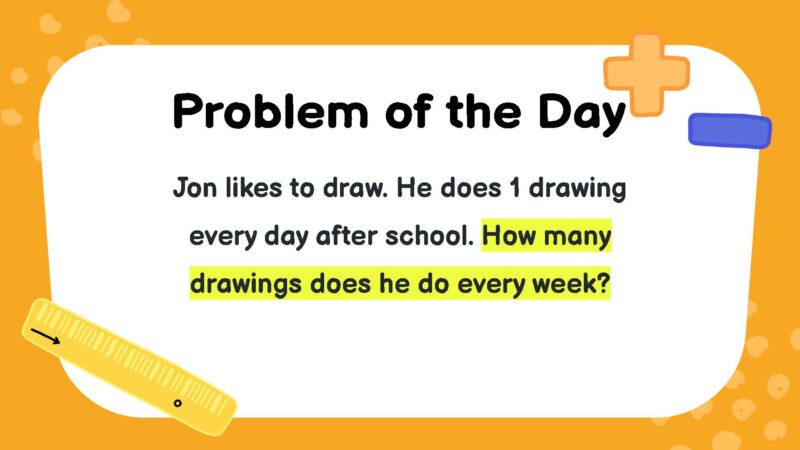Confession: It was my first year teaching and one month before the state test, I realized that I had failed to expose my students to enough word problems for them to be successful and confident with them. I was so caught up in the pacing guide and using the math textbook that I failed to make the math real world and situational for my students. Big mistake on my part and I had to spend the next month doubling down on word problems to make up for it.
Since that first year, I have learned a lot and started introducing word problems of the day as part of my math review or mini-lessons. On this post, I am sharing a free word problem of the day starter pack for you to use the first 20 days of school! This free word problem starter pack for 4th and 5th grade will set you on the right path of regular word problem practice and you won’t make the same mistake I did!
I touched on this a bit already but here are some more benefits of using a word problem of the day routine in your classroom:
- Continually exposes your students to word problems in a variety of contexts and with a variety of operations.
- When you use skill-based sets, you can ensure you only expose your students to word problems with skills they have been taught.
- Regular practice with word problem will lead to greater student success and, more importantly, confidence.
- Word problems will be a normal part of instruction and not seen as difficult or hard by students.
About the Word Problem of the Day Starter Pack
What skills are covered?
There are two versions, labeled Set A and Set B.
Set A has problems for addition and subtraction with 4-digit numbers and basic multiplication and division problems. There are also five multi-step problems. This set is ideal for the beginning of 4th grade (or the beginning of 5th graders who struggle with math).
Set B has problems for addition and subtraction with 6-digit numbers and multi-digit multiplication and division (multiplying by 1-digit only and dividing with 1-digit divisors). There are also five multi-step problems. This set is ideal for the beginning of 5th grade.
About the Format
Each set is available in three formats.
One problem per page format: This format works well for projecting the problems via a smartboard or printing them out to place at a math center.
One problem per page with student workspace: This format works well for giving each student a word problem daily. There is ample space for the students to organize and show their work.
One week per page: This format works well for paper-saving classrooms. All of the word problems for the week are on one page.
Using Review Skills to Begin the Year
I use the first month of school to really set the expectations and model for the students what I expect when they are solving word problems (read more about how we show the love with word problems here).
And it is so important that when teaching expectations and modeling a process, you use review skills that the students are already familiar with and have achieved mastery with. It is incredibly difficulty to try and teach students how you want them to solve a word problem using a math skill that they have not mastered yet. It will frustrate them and take away from the focus.
For that reason, I use these word problem of the day starter packs that contain skills from the previous grade level. This allows students to focus on the routine of solving a word problem daily and the process you want them to take before, during, and after solving a word problem.
Word Problem of the Day Routine
Speaking of the process, here is a brief run-down of how I use word problem of the day:
- I read the word problem and tell the students to focus on what is happening in the word problem.
- I ask for volunteers to reread the word problem and this time we focus on what the word problem is asking us.
- I ask 1-2 volunteers to retell the word problem in their own words.
- As a class, we restate the question into a sentence with a blank for the answer (this really ensures we know what the question is asking us).
- I give the students 1-2 minutes of private think time to think about how they will solve the problem.
- The students then get another 3-5 minutes of independent time to solve the problem. As the students are solving the problem, I monitor their understanding, ask guiding questions, and look for examples to share.
- We share what we think the answer is, how we got the answer, how we know it is correct, and the we plug it into our sentence (from step 4) and see if it makes sense.
The entire process takes about 15 minutes but is so valuable…and it does speed up as the year goes on and you can eliminate some of the steps.
How do I get the FREE word problem of the day starter pack?
Just put your email address in the box below and the starter packs (both Set A and Set B) will be sent to your inbox!
FREE Word Problem of the Day Packs
Join my email list to get the Word Problem of the Day Starter Packs for FREE! If you are already on my email list, you can sign up again for this freebie without getting duplicate emails. 🙂
Where can I buy more word problem of the day packs to continue this?
Once you finish with the starter packs, I have grade level sets available for purchase so you can continue your word problem of the day routine all year. The bundles include three main sets with three sets inside of the main sets for a total of 180 word problems. And the best parts are that the third set of each main set contains multi-step problems AND the sets are skill-based so you can ensure your students are only seeing word problems for skills you have taught. You can also mix and match the sets as you please.
Opening your daily math lesson with a Math Word Problem of the Day is an excellent way to set the stage for learning. We all know that word problems are difficult for young learners to grasp, even when the mathematical operation portion of the problem is basic. Incorporate these third grade math word problems one day at a time at the start of your math block to build confidence, critical thinking skills, and a learning community. Students will get used to reading slowly for meaning, while also identifying key information. Encourage students to write out equations and draw pictures to explain their thinking, since this helps them see the light when they are stuck!
Topics covered include addition, subtraction, multiplication, division, mixed operation, fractions, area and perimeter, and measurement. All you need to do is post one of these third grade math word problems on your whiteboard or projector screen, then let kids take it from there.
Want this entire set of word problems in one easy document? Get your free PowerPoint bundle by submitting your email here.
1. Gage went shopping and bought 19 cupcakes, 18 apple pies, and 47 glazed donuts. How many items did he buy altogether?
2. A shelter is taking care of 384 cats. 176 more arrive. How many cats are in the shelter now?
3. Gabby has 42 books on her bookshelf. Her dad gives her 23 more for her birthday. How many books does Gabby have now?
4. There were 823 people attending a soccer game after 37 people left. How many people were at the game before the people left?
5. Mr. Washington has 44 pencils. He found 37 pencils inside of the cubbies and opened a new pack of 60 pencils. How many pencils does Mr. Washington have in all?
6. Jeff plays Minecraft. On Monday he played for 67 minutes. On Tuesday he played for 32 minutes, and on Wednesday he played for 43 minutes. How many total minutes did Jeff play during the week?
7. Smith Elementary School has 286 boys and 241 girls. What is the total number of students that attend Smith Elementary?
8. Ashley rides her bike to school every day. The ride from her house to her school takes 21 minutes. If she has already been biking for 17 minutes, how much longer does she have to ride before she arrives at school?
9. Jason baked 93 cookies to sell at the school bake sale. He plans to take home whatever cookies he doesn’t sell. If he sold 77 cookies, how many cookies will he take home?
10. A school collects money for T-shirts. Third graders collected $327. Fourth graders collected 138 fewer dollars. How much money did fourth graders collect?
11. Hayden has 610 stickers. There are 250 in a white box and some in a yellow box. How many are in the yellow box?
12. The table shows students’ class points. Which two students’ scores have a difference of 15 points?
13. Ms. Brady has 356 tomato plants. She sells 91 of the plants and gives 49 of the plants away. How many tomato plants does Ms. Brady have left?
14. David’s mom buys apples for his class. There are 5 rows of 4 green apples. There is 1 row of 4 red apples. Fill in the blanks to complete the expressions.
15. A box of chocolates has 14 rows. There are 6 pieces of chocolate in each row. How many pieces of chocolate are in the box?
16. Christy and Jan are playing a card game. Christy has 4 cards and Jan has 4 times as many cards. How many cards do they have together?
17. Emerson is in charge of collecting the basketballs at the end of gym class. There are 6 bins, and 7 basketballs can fit in each bin. How many basketballs are there if each bin is full?
18. Luz had two pages of homework. Each page had five problems on it. How many total problems did she have to complete?
19. Keyanna was drawing on scrap paper. She could fit seven drawings on each page. If she has three pieces of paper, how many drawings can she make?
20. A bakery sells one sugar cookie for $2.00. How much will a dozen sugar cookies cost?
21. Mrs. Smith is getting her classroom ready for the first day of school. She has 25 students in her class. She wants 5 students to sit at every table. How many tables will she need?
22. Alex is organizing his school supplies. He has 141 index cards. He wants to split them into 3 piles. How many cards will each pile get?
23. Mrs. Blackley’s class plays a review game. The class earns 5 points every time they answer a question correctly. On Monday, the class earns 50 points playing the game. How many questions did the class answer correctly?
24. Maria has 56 gummy bears. She will give all the gummy bears to 8 of her friends. Each friend will get the same number. How many gummy bears will each friend receive?
25. Daniel has 63 coins and 9 piggy banks. If each piggy bank has the same number of coins, how many coins are in each piggy bank?
26. Leslie has 32 dolls in 4 baskets. Each basket has the same number of dolls. How many dolls are in each basket?
27. Levi has 10 fish in his fish tank. 4 fish are goldfish and the rest are minnows. What fraction of the fish are goldfish?
28. Melanie has 8 colored pencils. 3 are green, 2 are yellow, and 3 are blue. What fraction of the pencils are blue?
29. Hannah has a bag of M&M’s. There are 24 M&M’s in the bag. 8 are red, 6 are green, 7 are yellow, and 3 are brown. What fraction of the M&M’s are brown?
30. Mr. Brown needs to order pizza for 18 students. He wants each student to have ¼ of a pizza. How many pizzas should he order?
31. The class took a survey about favorite animals. ¼ of students chose lions as their favorite animal, and ½ of the students chose elephants. The other students chose either sharks or whales. Partition a circle graph to show these results.
32. John wanted a chocolate cake for his birthday. After blowing out the candles, he cut the cake. Out of his 12 party guests, only 6 ate cake. John let his friend Jackson take half the remaining cake home. What fraction of the cake was left over?
33. The area of a rectangle is 72 square units. One side has a length of 9 units. What is the other side length?
34. Monico drew a shape. It was a quadrilateral, and all sides were the same length. Which shape did Monico draw?
35. Gloria is buying a new rug for her bedroom floor. If the floor measures 12 feet x 12 feet, which size rug does she need?
36. The area of Happytown is 42 square miles. If the length is 7 miles, what is the perimeter of the town?
37. Aiden read 2 pages in his chapter book every day for 7 days. The book has 32 total pages. How many pages does Aiden have left to read?
38. Sophia has a twenty dollar bill. She buys six pop-it fidget toys for $2 each. How much money does Sophia have left?
39. There are 10 people at a cookout. Each person will eat 2 hot dogs. There are 8 hot dogs in a package. How many packages are needed?
40. Mrs. Potter bought 160 index cards. She gave the first row 55 index cards, then the second row 72 index cards. How many does she have left to give to the last row?
41. Samantha has 38 markers. She gives 29 markers to her classmates. Then she opens a new pack of 15 markers. How many markers does she have now?
42. There were 18 volleyballs in a bag and 13 volleyballs in a basket. 10 of these were used at recess. How many volleyballs were not used?
43. Mrs. Horton has 1 gallon of milk. She poured out 3 cups of milk. How many cups of milk does she have left?
44. Mark needs to buy yarn for 5 friends to do a science activity. Each friend needs 2 feet of green yarn and 1 foot of purple yarn. How many yards of yarn does Mark need to buy?
45. Nadine’s new jump rope is 4 inches longer than her old jump rope. Her old jump rope was 32 inches long. How long is Nadine’s new jump rope?
46. Dervin lined paper clips up in two rows. Each row was 18 feet long. How many feet of paper clips did Dervin have if he added the two rows together?
47. London started looking for her missing dog at 2:10 pm. It took her 43 minutes to find him. What time did London find her dog?
48. Damon took a train from his house to downtown. The train left the station at 1:08 pm and traveled 33 minutes before arriving downtown. What time did the train arrive?
49. Hannah worked on her homework for 37 minutes. If she started at 7:14 pm, what time did she finish her homework?
50. Kevin started cleaning his room at 6:03 pm. If he finally finished at 6:40 pm, how long did Ned spend cleaning his room?
If you like these third grade math word problems, check out our third grade hub for even more resources.
Get a PPT version of these word problems.
We know that word problems are often a struggle for students. My first year in the classroom, when my students sat down to do the complex, open-ended part of our state assessment in February, I had a gut-wrenching feeling that I hadn’t prepared them. We did some word problems within each of our units. But, those word problems weren’t very complex. And, students always knew exactly what to expect because it was exactly what we were practicing. On that day, I realized it wasn’t enough and I made changes immediately. As in, we started a new routine the next week. I began using a word problem of the day and haven’t looked back. Every single year since, no matter what grade I’m teaching, we do a daily word problem. It’s made a huge difference for my students.
Spiral Review with Word Problem of the Day
One of my biggest motivations for doing a word problem of the day is that it gives students a spiral review of the standards. When students are only working on a specific skill in word problems at a specific time, i.e. during each unit of study, they know what skill to look for. It takes some of the analyzation out of it. Students don’t have to truly make sense of the problem. By moving through various problems at different times, students truly don’t know what to expect. Their focus turns to what the problem is asking and they have to use the information presented to develop a plan for solving. This unexpected practice is critical for building strong problem solvers.
Spiraling the standards also gives students ongoing exposure and practice with each standard. This helps them connect that practice to what they already know and help build the synapses needed for long-term memory. Repeated, ongoing practice is key for many students to truly master something and have it become part of their long term memory. I also like when new skills are presented in this way, though it’s not intentional. Students get an opportunity to try applying what they already know using their problem solving skills to tackle something new. It’s fascinating, and reinforcing, to see students successful with new, not formally presented skills. Our focus is then on their thinking and strategy use.
Rigorous Test Prep
As I mentioned, it was upon seeing my students working on the state test that I realized our previous word problem work was not rigorous enough. Students are expected to solve complex word problems using several standards and skills at one time. The state assessment gives several multi-step word problems plus the in-depth performance task that asks students to apply what they know. They need repeated practice with complex multi-step word problems with various contexts. While my daily practice is not to the level of the performance task, it does give students opportunities to use different strategies to solve. It gives them practice making sense of complex problems. Our word problem of the day routine gives students the time to talk about math and their choices in solving problems.
Math Talk
Another huge motivation for our daily problem solving routine is our math talk. During our word problem routine we focus on making sense of the problem, using models, writing equations, and ensuring we’re answering the question that is asked. I scaffold students through the work, focusing on my expectations and our problem solving steps. After that, it doesn’t look the same every day. Because the problem content spirals, our routine changes. Sometimes, we work through the problem together immediately. Most often, though, students complete it on their own. Afterwards, they share their thinking. Sometimes, it’s with a partner. At other times, it’s with a small group. We always bring it back together whole group to talk about the equations identified and strategies used to solve. I also use this time to address any misconceptions and common mistakes. Making sense of the problem and using successful models and equations are the most important components of our daily problem solving routine.
Through our daily word problems, we spend a lot of time talking about the problem and students’ thinking. I explicitly teach and reinforce sentence stems that help guide students’ conversations with each other and for explaining their thinking. Justifying their answers and critiquing the work of others is complex work. Repeated daily practice and scaffolding gives all students an opportunity to engage in these conversations.
My Math Talk Posters are perfect for a classroom bulletin board display. You can get these 17 math talk sentence stems posters for free, in both colored and black and white versions, by filling out the chart below.
Newsletter
Sign up to receive your free Math Talk Sentence Stem posters! After confirming your email, you’ll receive the file and be signed up for my weekly newsletter.
Word Problem of the Day
I have year-long bundles of word problems for 1st through 3rd grades. I’ve used these story problems every day year after year as part of our daily problem solving routine. With 30 problems in each set, there’s an abundance of opportunities to practice. Some days we’re able to complete 2 or 3 problems. Most days, we complete just one. We spend 10-15 minutes on each complex problem since our focus is on so much more than just the answer. It’s important that our daily problem is complex and rigorous so that the focus is on making sense of the problem and students’ thinking around their models and strategies.
1st Grade Word Problems of the Day
Building successful problem solvers means intentional problem solving practice with even our youngest learners. My 1st Grade Word Problem of the Day sets start working at the most basic levels. Students focus on making sense of the problems, writing an equation, and using a given picture to help them solve for the unknown. Throughout their practice students work with a variety of word problems including part-part-whole and start-change-end problem types. They give ongoing practice with the range of addition and subtraction word problem types. Students complete bar models, part-part-whole tables, start-change-end tables, tens frames, and use models to help them make sense of addition and subtraction. You can take a closer look at my 1st Grade Story Problem set and download the free set perfect for the beginning of the year by clicking the images below.
2nd Grade Word Problems of the Day
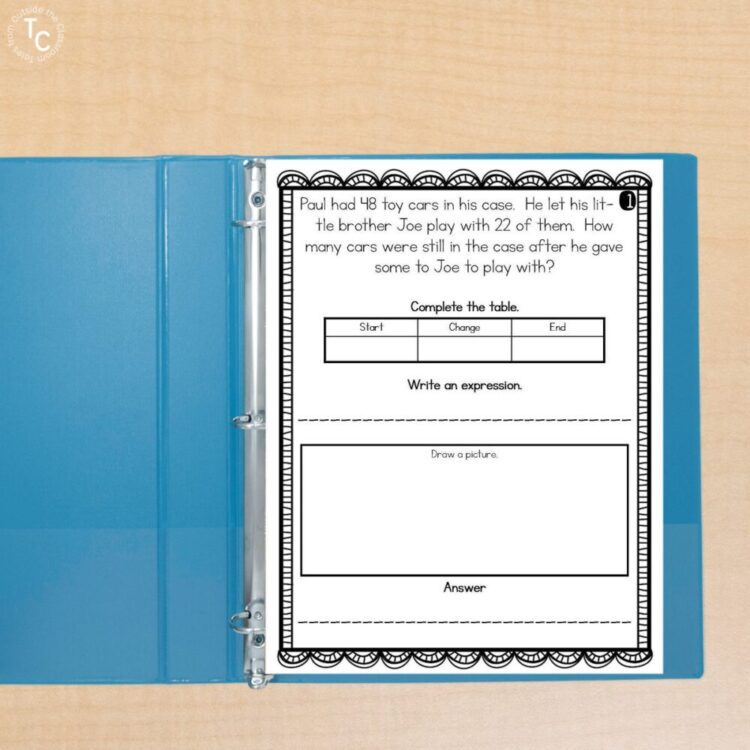
3rd Grade Word Problems of the Day
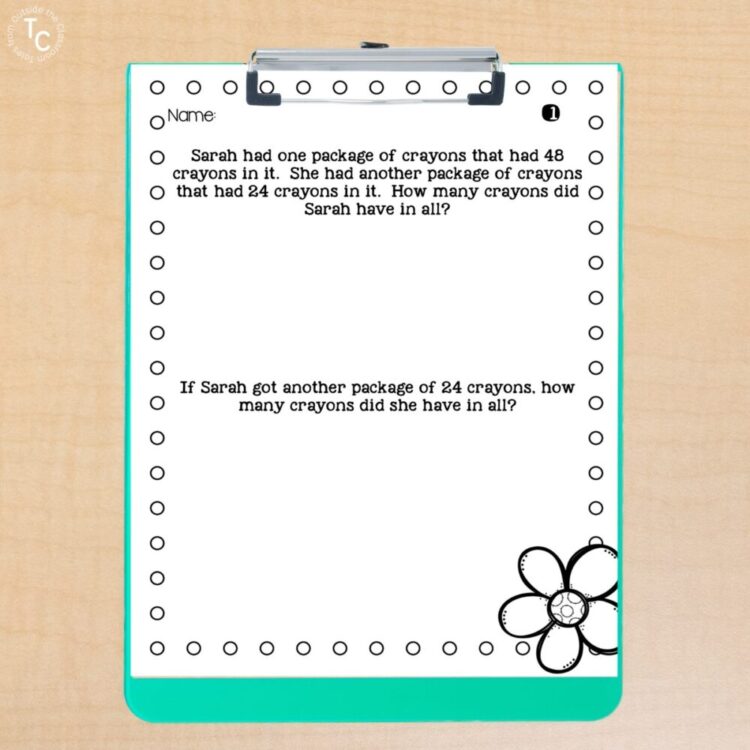
Our Word Problem of the Day, spiral review, and Number of the Day are absolute must supplements to our math block. Our daily problem solving practice gives students ongoing, rigorous practice with the standards and is a much-needed spiral review of the standards. You can read more about the specific steps in our daily routine in my 3 Reads Strategy post.
Choose your grade level and you’ll jump to a page with hundreds of practice word problems, one for each day of the school year. (These pages are in-progress. We’ll keep adding more until we have 30 weeks/150 worksheets per grade level.)

Daily Word Problems
Kindergarten (Level K)
In Kindergarten, daily math word problem series will allow children to practice counting numbers to 20, comparing numbers (using more, most, fewest, etc.), adding and subtracting within 10, and identifying basic shapes.
Grade 1 (Level A)
Daily word problem worksheets for 1st grade students. Most problems require basic addition or subtraction. There are also occasional problems related to counting money and skip counting.
Grade 2 (Level B)
This page has 2nd grade daily math word problems. At this level, we have both single-step and multi-step problems. Single, double, and triple-digit addition and subtraction are frequently featured. Other skills include elapsed time, counting money, and repeated addition (multiplication).
Grade 3 (Level C)
In third grade, students will be presented with 2, 3, and 4-digit addition and subtraction problems, as well as questions involving basic multiplication, basic division, place value, counting money, tables & charts, and fractions.
Grade 4 (Level D)
In 4th grade, the daily word problems will consist of more multi-step math, covering operations with whole numbers, fractions, and decimals. There will also be questions related to place value, angles, graphs, and measurement conversions.
Grade 5 (Level E)
These 5th grade daily math worksheets continue to build on elementary math skills. Multi-step problems cover operations with whole numbers, as well as fractions and decimals. Understanding place value, calculating measurements, and reading charts and graphs are among the other skills covered in these worksheets.
Math Buzz
This is a different set of daily review worksheets, featuring a variety of math skills. Each day, students have 5 math questions to answer. Not all problems are word problems in this set.
November 27, 2022
Word Problem Of The Day. Gage went shopping and bought 19 cupcakes, 18 apple pies, and 47 glazed donuts. Trey has 5 squishy toys.
He gets 4 more for his birthday. Word problem of the day. 5th grade math word problems | word problem of the day bundle by jennifer findley 631 $12.00 $9.00 bundle zip.
Starting your daily math lessons with Math Word Problems of the day is a great way to lay off learning. Word problems are usually a difficult topic for young learners to comprehend, even when the mathematical aspect is easy.
Integrate these first-grade maths word problems daily at the beginning of your math block to develop critical thinking, confidence, and a learning community. Students will adapt slowly to meaning while also interacting with key details. Motivate students to write out word problems equations and draw out pictures to explain their thoughts since this aids them in finding their way when they’re stuck.
Topics included are addition, multiplication, subtraction, and comparison. Your job is to put up one of these first-grade math word problems on the whiteboard. Then allow kids to do the needful.
50 First Grade Math Word Problems
- I had six pencils. If my teacher gave me an additional four, how many pencils do I have?
- Gina’s dog took three treats on Sunday with 0 on Monday. How many treats did Gina’s dog take altogether?
- Joel went on a zoo visit with his family. He saw a bear, three lions, and two tigers during his first hour. How many animals did Joel see during his first hour at the zoo?
- Jackson arranged his toy cars by their color. Jackson has six blue, four black, and five green cars. How many cars does Jackson have altogether?
- Ben owns two green balloons and four yellow balloons. How many balloons does Ben have in all?
- We have three children in the Clark family. Tina is three years old, Joshua four, and Samantha is seven. What is the sum you add up the age of the three children?
- If you go swimming, and 6 of your pals come along, how many are the swimmers?
- The flower in the vase used to be for Rachel’s mom. Three of the flowers dropped then Rachel’s mom had them taken out. Presently there are five fresh flowers in the vase. How many flowers had now been in the vase?
- The cat belonging to Hayden had a litter of kittens. Three were gray, two-spotted, and seven were black. How many kittens did Hayden’s cat have altogether?
- Pedro took the playground’s three red and six yellow leaves. How many leaves does Pedro have in total?
- Gabriella studied three books on Monday, six on Tuesday, and four on Wednesday. How many books were read altogether?
- Should you have three cats, two guinea pigs, and one bunny. How many little noses do they have in total?
- If 3 inches of snow are placed on the ground in the morning, we add three more inches again by dinner time. How many inches of snow do we have that day?
- My cat has four paws, while my brother’s dog has four paws. How many paws are there in sum?
- He has 10 pennies, but he misplaced 2 of them. How many pennies does he have now?
- Jason read seven books during the summer. Clark read five books too. How many more books did Jason read than Clark?
- Drake placed ten stickers on his notebook. But when he got to school, he observed some stickers had fallen off. Now Drake only has six stickers on his notebook. How many stickers fell off Drake’s notebook?
- Nicole loves to help her mom pick tomatoes from their family garden. She picked nine tomatoes in the garden. Six of them were red, and the others were green. Then they selected all the red tomatoes. How many green tomatoes were left in the garden?
- My sister and I have 30 pennies. If I have 10 pennies, how many pennies does my sister have?
- The zoological garden had eight tigers. Three of them moved to another zoo site. How many tigers are left?
- Matthew read three poems. Martha read some more than Matthew. Altogether they read seven poems. How many poems did Martha read?
- Haley’s dad purchased eight sandwiches. Haley ate 1of them. How many sandwiches does Harley’s dad have left?
- If you boiled seven eggs, the number of floating eggs was one more than the ones that sank. How many eggs float?
- Rasheed loves jelly beans. His favorite are the yellow ones. In his bag were 12 jellybeans. How many yellow jelly beans did Rasheed eat?
- The gym instructor had five basketballs. The following week, he added some new ones; now, they are nine. How many new basketballs did the gym instructor get?
- Saheed has six toy cars, and his brother Kamal has four more cars than him. How many more toy cars does Saheed have than his brother Kamal?
- Andrew has some marbles. His younger brother gives him five more. Now Andrew has eight marbles. How many marbles did Andrew have initially?
- Should you have an 8-pack of crayons, and you offer 3 to two of your friends to use during drawing time? How many crayons do you have left in your pack now?
- Jane has four pink erasers and some blue erasers. She has seven erasers in total. How many blue erasers does Jane have?
- Lyla serves pizza at her birthday fiesta. The pizza has 12 slices. Lyla and her guest ate eight slices of the pizza. How many pizzas do we have left?
- Consider if you have nine toys and your brother has six. How many more toys would you have?
- There are eight windows in the classroom. Where some of the windows have decorations, 2 of them do not have directions on them. How many classrooms have decorations?
- On Friday, you procured some fish from the pet store. Suppose 15 of the 18 fishes have stripes. How many of the fish don’t have stripes?
- 8 birds pitched on a fence top. Some birds flew away, and six birds stayed behind. How many birds flew away?
- There are six books on Nathan’s shelf. Noah took some of the books. Now there are two books left on the shelf. How many books did Noah take?
- Laird has some folders in his backpack and five on his desk. He has eight folders in total. How many folders are in his backpack?
- Liam has got 8-shorts. Five have superheroes images on them, while the rest have solid colors. How many of Liam’s shorts are of solid colors?
- Evelyn was fixing a 20-piece puzzle. After fixing her, she realized that only 18 pieces were there. How many pieces were missing?
- Nathan has seven cousins. Some of them are girls, while 3 of his cousins are boys. How many girl cousins does Nathan have?
- It rained snow for 7 hours on Monday and five on Tuesday. How many more hours did it rain and snow on Monday?
- Dan’s mom baked ten chocolate chip cookies for dessert. Dan ate two cookies while his mom ate one cookie. How many chocolate cookies were left?
- Angela has 16 purple pens. Alex has ten green pens. Angela has ___ more pens than Alex has.
- Dora has 75 pennies in her bank. How many pennies will she need to have 100 pennies in her bank account?
- on the table were 9 cups of soda. Some of the cups were knocked over, while six were still standing. How many soda cups were knocked over?
- Charles has 20 board games. The part was under his bed, while 15 were in his closet. How many board games were under Charles’s bed?
- Romano sighted three deer sitting at the top of a hill, but all he could see were their eyes. How many were the eyes Romano saw in all?
- Elliot saw five bunnies. He numbered all their ears. How many bunny ears did Elliot count?
- Kate counted all of her toes and her mom’s toes too. How many toes did Kate count in total?
- Which has more weight? A 15-pound red fox or a 24-pound turkey?
- Which has more weight? A 110-pound kangaroo or a 150-pound white-tailed deer.
Word problems are a fun way to build logic and comprehension skills. These particular problems focus on language rather than math. Children have to pay close attention to the wording and details to solve the problems. Introduce a problem a day as a warm up activity. Because these are made for young students, the vocabulary and situations are relatable and familiar, built around a family named the Wordly’s. There is a performance assessment after every 7 problems, and 77 total problems (not counting the testing opportunities.) Here is a problem from the middle of the book called Pajama Drawer:
First is the word problem, «The youngest Wordly boy’s dresser holds his pajamas, pants, & shirts. The dresser has 3 drawers. Each type of clothing is in a separate drawer. The middle drawer holds his shirts. His pants are in the bottom drawer. In which drawer are his pajamas? Then you talk about it, «Are his pants & pajamas in the same drawer? (no) How many drawers are there? (3) How many different types of clothing are there? (3) The next step is called picture it: (materials: paper & pencil) Draw 3 drawers. Draw to show where the shirts are. Draw where the pants are. Draw where his pajamas are. And finally, the solution: The pajamas are in the top drawer.
The performance assessments have this same format, the students are just doing it without any help from you. In the back is a page index where you can look up a certain skill such as time, money, shape, sequence, etc. The problems are short and sweet, as a warm up should be, but are enough to get your little learners thinking critically and actively. Spiral bound, sc, 6.5×8.5″, 90pp ~Sara
Build comprehension skills and teach vocabulary with these clever word problems. Each day’s problem is introduced with a word story featuring the Wordly family. Children listen carefully to details, visualize, then solve the problem using strategies such as drawing a picture or acting out the story. While many problems include numbers, the focus is on comprehension rather than math skills. 96 pages. Spiral bound.
When autocomplete results are available use up and down arrows to review and enter to select. Touch device users, explore by touch or with swipe gestures.
Word problem of the day is a great way to incorporate word problems into your instruction. Grab a FREE word problem of the day starter pack!
Word problem of the day is a great way to incorporate word problems into your instruction on a regular basis. Grab these FREE word problem of the day starter packs for 4th and 5th grade on this post.
Word problem of the day is a great way to incorporate word problems into your instruction on a regular basis. Grab these FREE word problem of the day starter packs for 4th and 5th grade on this post.
Comments
Opening your daily math lesson with a word problem of the day is an excellent way to set the stage for learning! Incorporate them at the start of your math block to build confidence, critical thinking skills, and a learning community. Students will get used to reading for meaning, while also identifying key information. Encourage students to write out equations and draw pictures to explain their thinking, since this helps them see the light when they are stuck!
Topics in these kindergarten math word problems cover addition, subtraction, comparison, number sense, comparing numbers, and measurement. Want this entire set of kindergarten math word problems in one easy document? Get your free PowerPoint bundle by submitting your email here. All you need to do is post one of the problems on your whiteboard or projector screen. Then let kids take it from there.
1. Sue has 2 markers. Tom has 3 markers. How many markers do they have all together?
2. There are 4 red blocks on the rug. There are 4 yellow blocks on the rug. How many blocks are on the rug in all?
3. Sam has 3 marbles. Tim gave Sam 1 marble. How many marbles does Sam have now?
4. One cat is in the yard. 4 more cats come into the yard. How many cats are in the yard now?
5. Jill had 7 toy cars. She got 3 more for her birthday. How many toy cars does Jill have now?
6. Ava has 2 more books than Lucy. Lucy has 6 books. How many books does Ava have?
7. There are 7 red chairs and 2 green chairs at the table. How many chairs are at the table all together?
8. Pete put 2 pencils in his desk. There were 3 pencils in there already. How many pencils are in Pete’s desk now?
9. Tina has 4 jackets at home and 2 jackets at school. How many jackets does Tina have in all?
10. Bob has 5 more stamps than Bill. Bill has 2 stamps. How many stamps does Bob have?
11. James has 5 flowers. He gives Lisa 3 flowers. How many flowers does James have left?
12. 8 birds were on the playground. 5 birds flew away. How many birds are still on the playground?
13. Karen had 4 peanuts. She ate 3 of them. How many peanuts does Karen have left?
14. There are 6 boxes on the truck. 4 boxes are blue. The rest are green. How many boxes are green?
15. Frank has 7 donuts. If he gives 3 away, how many donuts will he have left?
16. Tim had 5 balls at home. He took 1 ball to school. How many balls did he leave at home?
17. There are 10 pieces of fruit in the bowl. 2 are apples. The rest of the fruit are oranges. How many oranges are in the bowl?
18. Kris has 5 stickers. She gives Dave 4 of her stickers. How many stickers does Kris have left?
19. Lisa drew 4 pictures. Kelly drew 6 pictures. Who drew more pictures? How many more?
20. Malik has 10 balls of clay. He gives 10 of the clay balls to Rob. How many clay balls does Malik have now?
21. Sara wants to make 8 cards. She already made 4 of them. How many more cards does Sara need to make?
22. The class sang 5 songs. They want to sing 10 songs. How many more songs does the class want to sing?
23. Rose had some beads on her bracelet. She got 3 more beads and put them on. Now she has 6 beads all together. How many beads did Rose have at the start?
24. Mr. Jones had 4 pens. He bought some more pens. Now he has 6 pens. How many pens did he buy?
25. Lilly has 3 pink hats, 2 white hats, and 1 purple hat. How many hats does Lilly have in all?
26. Pat has 4 erasers. Ken has 2 erasers. Jason has 2 erasers. How many erasers do they have all together?
27. There were some animals in the barnyard. There were 5 goats, 4 cows, and 1 sheep. How many animals were in the barnyard all together?
28. South Street has some houses on it. 3 houses are blue, 1 house is gray, and 4 houses are white. How many houses are on South Street?
29. Meg has a cat, 2 dogs, and a parrot. How many pets does Meg have?
30. Ken likes to plant trees. He planted 7 pine trees, 2 oak trees, and 0 spruce trees. How many trees did Ken plant all together?
31. Ms. Matho gave her class this pattern and asked them to finish it: 3, 4, 5, 6, __, __. What should the last two numbers be?
32. Ian has a pattern on his shirt. It was blue stripe, red stripe, blue stripe, red stripe. What color is the next stripe?
33. The countdown started. The class called out, “10, 9, 8, 7, 6…” What were the next two numbers they called out?
34. Joan was counting her socks by two’s. She had 4 pair of socks. How many socks is that all together?
35. Faith’s hat has a letter pattern on it. It goes A,B,C, A,B,C. What letter comes after B in the pattern?
36. Larry has 12 stamps. Barry has 11 stamps. Who has more stamps?
37. There were 20 yellow backpacks. There were 19 blue backpacks. Which color were most of the backpacks?
38. Jessica had some crayons. Pam had 15 crayons. Jessica had 2 more crayons than Pam. How many crayons did Jessica have?
39. Stan had 14 pennies. Dave had 9 pennies. Who had less pennies?
40. Beth was 8 years old. Her sister, Lori was 10 years old. Who is older? How much older?
41. The stick was 10 inches long. It was painted red and white. 5 inches of the stick were red. How much of the stick was white?
42. Frisky the cat weighs 6 pounds. Mittens the cat weighs 9 pounds. Which cat weighs more? How much more?
43. 17 is Chan’s lucky number. The number that comes before Chan’s is Ming’s lucky number. What is Ming’s lucky number?
44. The buses are all lined up in number order. The #12 bus is Juan’s bus. What number bus comes right after Juan’s bus?
45. Stacey practiced soccer for 6 hours last week. Emily practiced soccer for 4 hours last week. Who practiced soccer longer? How much longer?
46. Mrs. Tang’s class got 18 new books from the book fair. Mr. Smith’s class got 15 new books from the book fair. Which class got more new books from the book fair?
47. There are 10 children at the lunch table. 4 are boys. The rest are girls. How many children at the lunch table are girls?
48. The doors in the school are in number order. Carol is in Room #11. Delia is in the room right before Carol’s. What room is Delia in?
49. There are 3 boxes. The pink box has 4 balls in it. The orange box has 2 balls in it. The black box has 2 more balls than the pink box. Which box has the most balls? How many are in that box?
50. Jon likes to draw. He does 1 drawing every day after school. How many drawings does he do every week?
Enjoying these kindergarten math word problems? Check out our kindergarten hub for even more resources.
Get a PPT version of these word problems.
Download

Skip this Video
Loading SlideShow in 5 Seconds..
Word Problem of the Day 3 rd Grade PowerPoint Presentation
Word Problem of the Day 3 rd Grade. Begin in January. Day 1. Jack has 5 bags. There are 6 shells in each bag. How many shells does Jack have in all?. Day 2. Jane had 60 inches of string. She cut the string into 6 equal pieces. How long is each piece of string?. Day 3.
Uploaded on Oct 21, 2014
- day
- people visited
- 5 plants
- 50 grams
- puts 5 markers
- making 2 peach pies
Download Presentation
Word Problem of the Day 3 rd Grade
— — — — — — — — — — — — — — — — — — — — — — — — — — — E N D — — — — — — — — — — — — — — — — — — — — — — — — — — —
Presentation Transcript
-
Word Problem of the Day 3rd Grade Begin in January
-
Day 1 • Jack has 5 bags. There are 6 shells in each bag. How many shells does Jack have in all?
-
Day 2 • Jane had 60 inches of string. She cut the string into 6 equal pieces. How long is each piece of string?
-
Day 3 • Mr. Benito has 50 markers. He puts 5 markers into each bag. Then he gives two bags of markers to Mr. George. How many bags of markers does Mr. Benito have left?
-
Day 4 • Andrew paid $3 for each of 5 books. David paid $5 for each of 2 books. Who paid more for his books?
-
Day 5 • The total mass of 5 new crayons is 50 grams. What is the mass of each crayon?
-
Day 6 • Ethan has 138 United States stamps and 91 stamps from other countries. How many stamps does Ethan have in all?
-
Day 7 • There are 112 boys and 93 girls who attend Spring Road Elementary School. About how many students attend this school in all?
-
Day 8 • Rory has 132 baseball cards in his collection. His grandfather gives him 175 more cards. About how many cards does he now have in his collection?
-
Day 9 • In June, 394 people visited the Science Museum. In July, 426 people visited the Science Museum. How many people visited the Science Museum in June and July?
-
Day 10 • Chen put a new tile floor in his kitchen. There are 9 rows of tiles with 7 tiles in each row. How many tiles did Chen use?
-
Day 11 • Rosa made 56 cupcakes. She put 8 cupcakes into each box and sold the boxes for $3 each. How much money did Rosa receive?
-
Day 12 • There are 10 slices in each loaf of bread. Nancy bought 4 loaves of bread. She used 2 slices to make a sandwich. How many slices of bread are left?
-
Day 13 • On Saturday, 304 people visited the zoo. On Sunday, 488 people visited the zoo. Estimate to find the total number of people who visited the zoo?
-
Day 14 • Tamika has a stamp album. There are 8 stamps on each of 8 pages. How many stamps are there in all?
-
Day 15 • The mass of a large box of cereal is 750 grams. The mass of a small box of cereal is 435 grams. How much greater is the mass of the large box of cereal than the mass of the small box of cereal?
-
Day 16 • The supermarket manager arranged 40 cans of soup into equal rows with 5 cans in each row. How many rows of soup cans are there?
-
Day 17 • James wants to buy a soccer ball worth $95 and a bike worth $349. If he only has $375 how much more money does he need?
-
Day 18 • Chris had 42 marbles. He gave two friends each 10. How many marbles does Chris have now?
-
Day 19 • Maria had three sets of 13 yellow cards. How many cards does she have in all?
-
Day 20 • On Monday Lia read 4 times as many pages of her book as Jess. Lia read 100 pages. How many more pages did Lia read than Jess?
-
Day 21 • Hudson has 2 full reels of fishing line. He has a total of 20 yards of line. There are 3 feet in a yard. How many feet of fishing line are on each reel?
-
Day 22 • Brad has 7 packs of 5 basketball cards and 3 extra cards. How many cards does Brad have in all?
-
Day 23 • Lauren has saved $293 to buy a computer. If the computer costs $615, about how much more does Lauren need to buy the computer?
-
Day 24 • Mrs. Lopez shared 10 grapes equally between her 2 children. Then she gave each child 2 more grapes. How many grapes did each child have?
-
Day 25 • Jacob started reading at 4:30. He stopped reading at 4:49. For how many minutes did he read?
-
Day 26 • Lisa has 5 rows of flowers. There are 25 flowers total. How many flowers were in each row?
-
Day 27 • Tanya had 147 flower stickers and 119 animal stickers. She bought 16 more animal stickers. How many flower and animal stickers did Tanya have then?
-
Day 28 • Marie runs 11 miles in three days. She runs 3 miles on each of the first two days. How many miles does she run on the third day?
-
Day 29 • Sam has 15 apples. He places an equal number of apples on each plate. He has 3 plates. How many apples does he put on each plate?
-
Day 30 • Tim is digging holes to plant seeds. Tim has 32 seeds. He puts 4 seeds in each hole. How many holes does he dig?
-
Day 31 • Tomas has a dozen eggs. He uses some eggs to make breakfast. After breakfast, he has 9 eggs left. How many eggs did he use?
-
Day 32 • Jane is making 2 peach pies. She puts 8 peaches in each pie. How many peaches does she need?
-
Day 33 • Jenna is planting a garden. She has 15 plants. She arranges the plants into equal rows with 5 plants in each row. How many rows of plants will there be in Jenna’s garden?
-
Day 34 • Carla has 4 rows of rose bushes in her garden. Each row has 6 bushes. If she plants one more row of 6 bushes, how many rose bushes will she have?
-
Day 35 • Brad bought a computer for $453 and a printer for $96. Maria bought a television for $399 and a DVD player for $148. How much more did Brad spend than Maria?
-
Day 36 • A cow weighs 519 pounds. Her calf weighs 296 pounds. How much more does the cow weight than the calf?
-
Day 37 • Phillip baked 36 cookies. Caden ate 2 cookies. Riley ate 4 cookies. How many cookies does Phillip have left?
-
Day 38 • Anna had 3 boxes with 6 muffins in each box. Anna and her friends at 4 of the muffins. How many muffins are left?
-
Day 39 • There are 3 apple tarts and twice as many peach tarts. How many tarts are there in all?
-
Day 40 • A grocery store sells yogurt cups in packs of 5. The store sold 9 packs yesterday. How many yogurt cups did they sell yesterday?
-
Day 41 • A moving man packed three boxes of six items and six boxes of 3 items. How many items did the moving man pack in all?
-
Day 42 • The area of the rectangular rug is 20 square feet. The width is 4 feet. What is the perimeter of the rug?
-
Day 43 • Ana read 9 pages of a book. Robert read twice as many pages. How many pages did they read in all?
-
Day 44 • Stephan has a rectangular fence running along the perimeter of his yard. The length of the fence is 20 meters long. The yard area is 300 square meters. What is the width of the fence?
-
Day 45 • Mary and 3 friends shared 32 crayons equally. How many crayons did each person get?
-
Day 46 • Rahid needs 8 pieces of wood that are each 30 inches long. How many inches of wood does Rahid need altogether?
-
Day 47 • Carols has 72 stickers. He wants to put the same number of stickers on each of the 9 pages in his sticker album. How many stickers will Carlos put on each page?
-
Day 48 • Tina started biking to the library at the 11:04. She arrived at the library at 11:11. How long was Tina’s bike ride to the library?
-
Day 49 • Kim bought 3 pens. Each pen costs 30 cents. How much did Kim spend on all of the pens?

